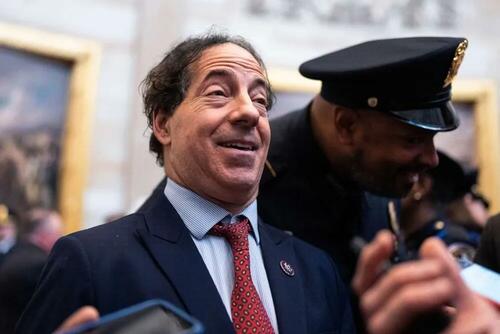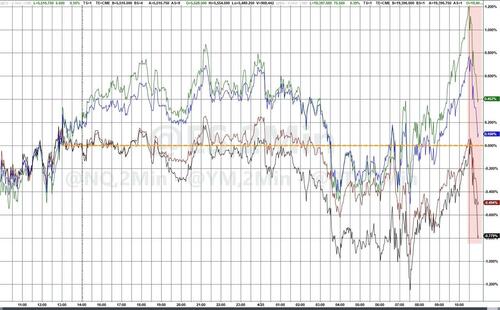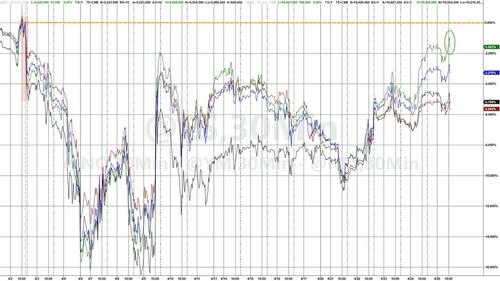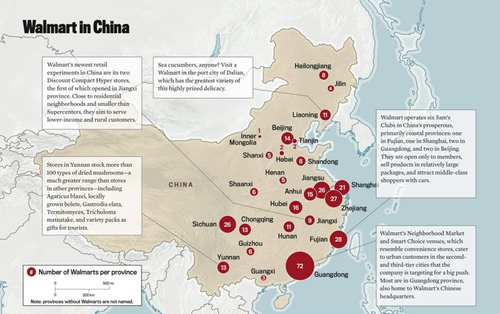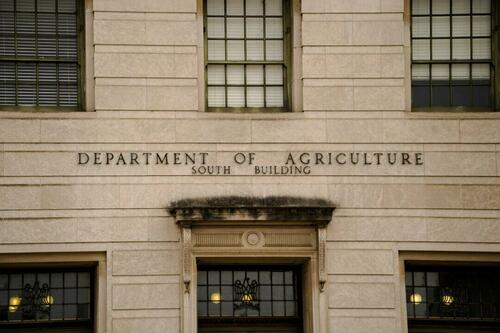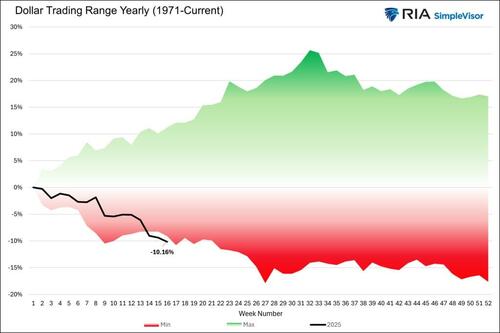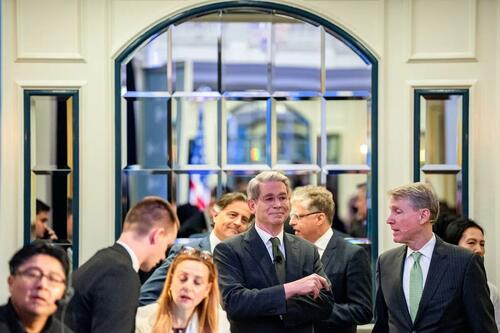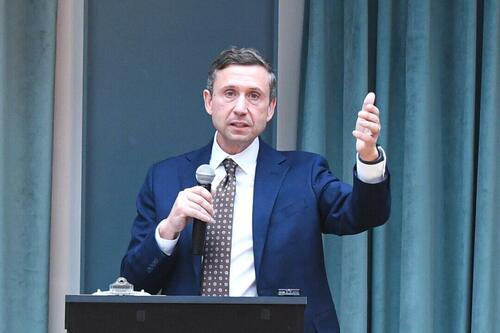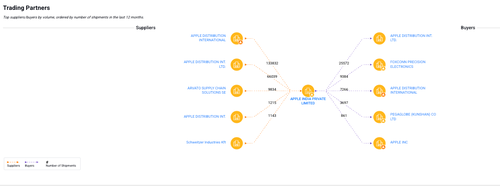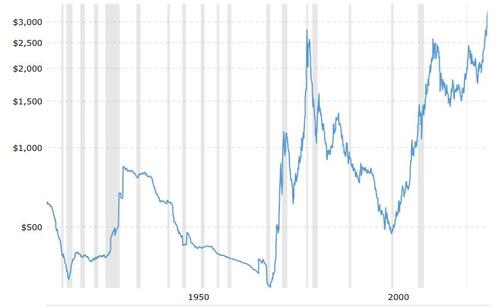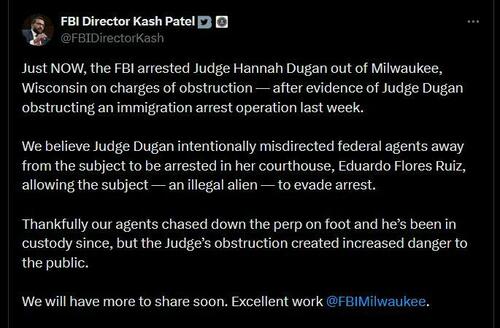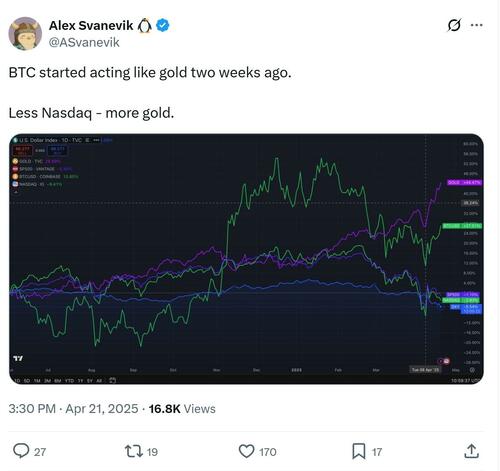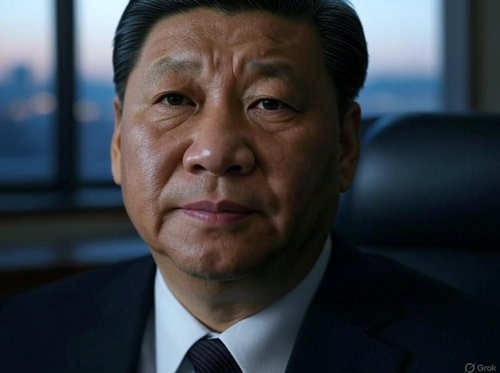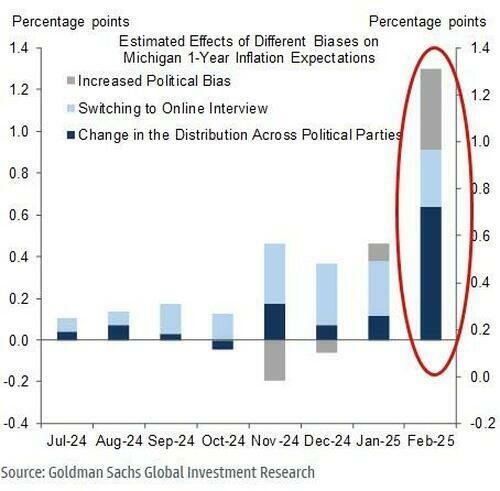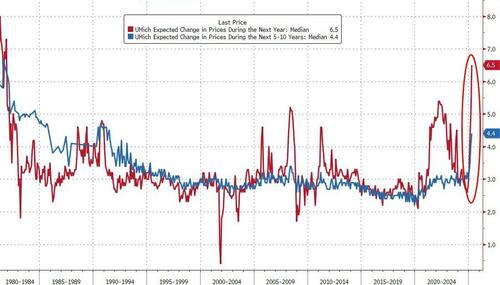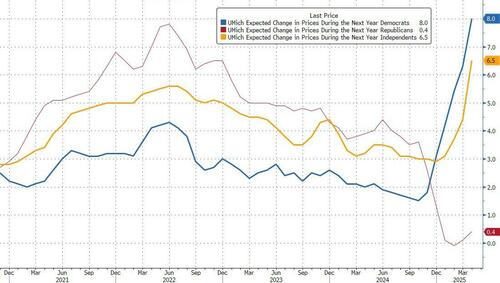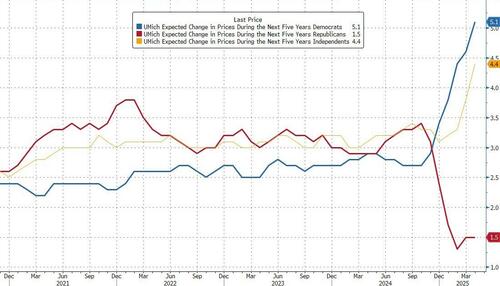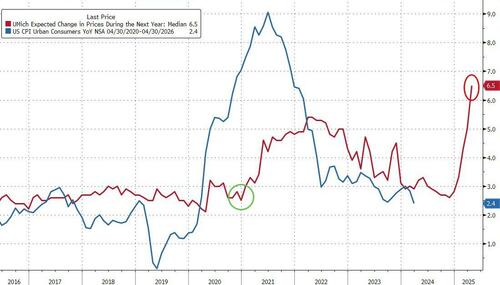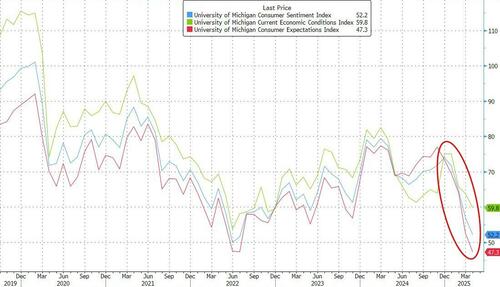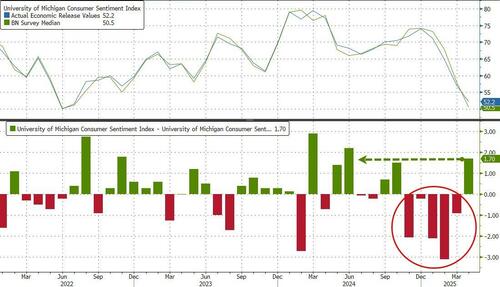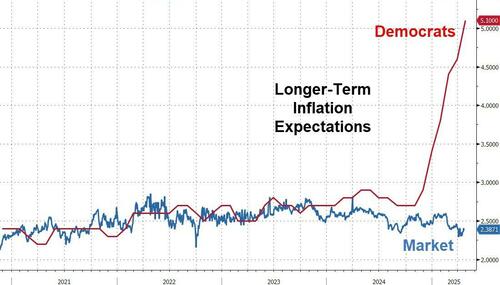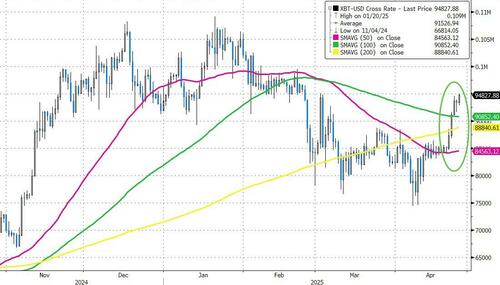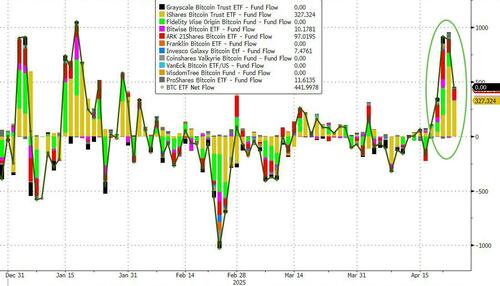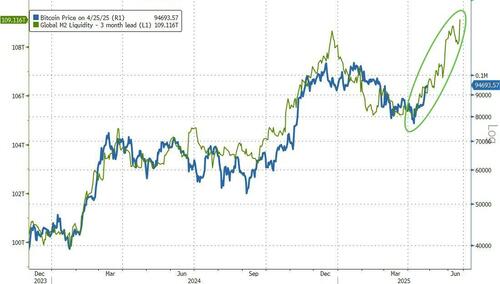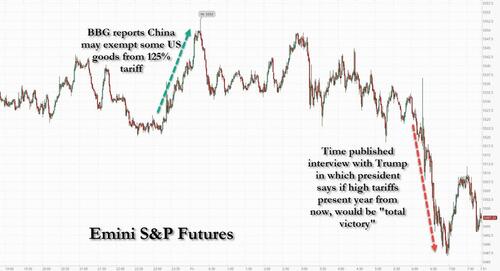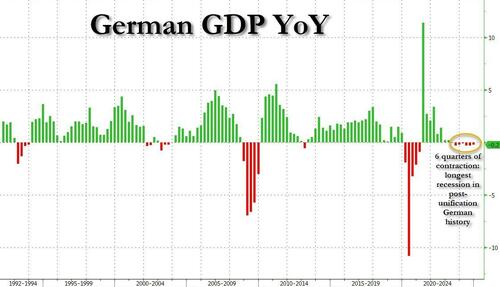To live without faith, without a patrimony to defend, without a steady struggle for truth – that is not living, but existing.
Distinction Matter - Subscribed Feeds
-
Site: southern orders
-
Site: southern orders
-
Site: Zero Hedge"We Are In A Homelessness Crisis": California Democrat Wants To Let Broke Students Sleep In Their CarsTyler Durden Fri, 04/25/2025 - 16:40
As California spends over half its budget providing 15 million residents with Medi-cal coverage - a substantial portion of whom are 'undocumented,' one state Democrat has proposed new legislation that would allow college students to sleep in their vehicles as the Golden State grapples with a worsening homeless crisis.
 Brad Butterfield pauses after checking the top of his RV for leaks in Arcata on Aug. 24, 2024. Photo by Alexandra Hootnick for CalMatters
Brad Butterfield pauses after checking the top of his RV for leaks in Arcata on Aug. 24, 2024. Photo by Alexandra Hootnick for CalMatters
Left-wing Assemblymember Corey Jackson introduced a bill mandating that California State University chancellors and community college district governing boards collaborate with basic needs coordinators and campus security to establish an overnight parking program by late 2026, Fox News reports.
"This bill confronts a harsh reality to many of our students who are sleeping in their vehicles or other displaced settings as they are unable to find affordable housing, and that's jeopardizing their education," the California Democrat said. "What I am proposing is practical, immediate relief, overnight parking programs that turn campus lots into safe, temporary havens while the state works on lasting solutions."
"We are in a housing crisis. We are in a homelessness crisis, and it's not an either or approach. It's a both and all of the above approach," he added.
The Community College League of California released a survey revealing that three in five California community college students face housing insecurity, with one in four experiencing homelessness.
While America is the home of the free (or at least it used to be) and sleeping in one’s car should be one’s prerogative, the bill raises questions about California Gov. Gavin Newsom’s (D) handling of his state’s housing affordability.
Fox News reports:
Newsom's office, citing 2024 records, stressed that homelessness is increasing nationwide by more than 18%, while California's national trend is closer to 3%, lower than 40 other states. Newsom also touted the state's more than 71,000 year-round shelter beds, which a spokesperson said is double the amount created during the 5-year period prior to the Newsom administration.
Unsurprisingly, California Republicans are not fans of the proposal and say California Democrats should focus on solving the root of the issue.
"After wrecking affordability in California, Democrats have nothing left but bad ideas," California Assembly Republican Leader James Gallagher said in a statement to Fox News. "They’re now proposing to let students sleep in cars because they can’t fix the housing crisis they created. This isn’t innovation. It’s desperation from a party that spent decades raising costs, blocking new housing and wasting billions on programs that failed. Letting students live in parking lots isn’t a solution. It’s proof their policies have completely collapsed."
 A California lawmaker proposed a bill that would allow California college and university students to sleep in their cars. (Fox News Digital)
A California lawmaker proposed a bill that would allow California college and university students to sleep in their cars. (Fox News Digital)
Fox News contributor Hugh Hewitt had this to say about the plan: "The problem in California is there are not enough homes and apartments. It's a supply problem created over 50 years of no-growth, left-wing policies that are anti-housing. The solution is not to create homeless encampments, and each one of these will become that. People are going to enroll in the community college for 18 bucks a credit, and then they're going to put their car in the community college parking lot."
Newsom's office, when reached for comment, refused to weigh in on the bill: "California is bucking not only national increases but reversing long-term trends in the state from decades of inaction prior to this administration. California’s progress in addressing homelessness is outperforming the nation.”
* * *
After selling out quickly, 10 of these just showed up! Free Shipping. (click pic)
Sneak Peek: New offerings at ZeroHedge Store...
-
Site: LifeNews
As Planned Parenthood faces growing scrutiny over patient safety and service quality, a surge of political advertising seeks to shield the organization while targeting pro-life lawmakers.
The ads, backed by Reproductive Rights for All (formerly NARAL), attempt to portray legislative efforts to defund abortion providers as attacks on women’s health care, Susan B. Anthony Pro-Life America reported.
“These ads peddle false claims about defunding Big Abortion chains like Planned Parenthood,” said Marjorie Dannenfelser, president of Susan B. Anthony Pro-Life America. “They want the viewer to believe defunding abortion businesses would cut benefits to women. Nothing is further than the truth.”
Dannenfelser emphasized that ongoing pro-life efforts to shift taxpayer funding do not reduce women’s health benefits but instead aim to redirect resources away from abortion providers and toward federally qualified community health centers, which she noted “outnumber Planned Parenthood by 15 to 1.”
LifeNews is on GETTR. Please follow us for the latest pro-life news
The political spin comes as new revelations spotlight Planned Parenthood’s declining health care services and troubling operational practices. A recent New York Times exposé detailed unsanitary and negligent conditions, including a facility in Nebraska where a sewage leak lasted several days, making women vomit from the stench. Other documented incidents include the implantation of an IUD in a woman who was unknowingly pregnant — resulting in a stillbirth — in Nebraska and the use of moldy medical equipment in Missouri.
“But if the unsanitary conditions revealed by the New York Times aren’t enough, consider this: while Planned Parenthood’s government money has gone up, their contraceptive and cancer screening services have plummeted,” Dannenfelser added. “The services that have gone up are abortion, gender transitions and political campaigns to defeat Donald Trump and Republicans.”
Katie Glenn Danel, director of legal affairs and policy counsel at Susan B. Anthony Pro-Life America, criticized Planned Parenthood’s current trajectory.
“Planned Parenthood is an abortion business, not a health care provider,” she said.
Danel pointed to data showing a 43% increase in taxpayer funding since 2010, while services such as cancer screenings, breast exams, and pap smears have dropped by more than 70%.
“Women deserve quality, comprehensive care,” Danel continued, later adding, “Americans will no longer subsidize the industry that endangers women, kills unborn children and spends millions to elect woke politicians.”

The post Abortion Activists Say You Hate Women if You Don’t Want Your Tax Money to Fund Abortions appeared first on LifeNews.com.
-
Site: Zero HedgeWhere Things StandTyler Durden Fri, 04/25/2025 - 16:20
Authored by James Howard Kunstler,
“In order for a system to be stabIe, it requires negative feedback, also known as consequences.”
- Barrie Drain
“Fighting fascism,” for the American Jacobins who lead the Democratic Party, means opposing any attempt to flush the corruption out of the entrenched bureaucracy, just as their pet phrase “our democracy” actually refers to the matrix of grift and despotic activism that drives their political operating system. That is exactly how and why the USAID was so crucial to spread captured taxpayer spoils as NGO salaries for the gender studies grads to play “activist,” so as to inflict their special brand of sadistic power madness over the land — to keep the game going.
Now, USAID is scattered to the winds and all they have left is their installed base of federal judges and the horde of lawfare lawyers who feed them bogus cases to halt the remaining work of Mr. Trump’s executive branch clean-up operation.
Remember: Robespierre, leader of the Jacobins in the French Revolution, was a lawyer.
Their version of defending “our democracy” in 1793 was the Reign of Terror that sent at least 17,000 political opponents to the guillotine.
Rep. Jamie Raskin (D-MD)
Rep. Jamie Raskin (D-MD) is the Democrats’ Robespierre. He is promising his own reign of terror when his party recaptures Congress in the 2026 “midterm” election.
Norm Eisen is his chief lawyer and legal strategist. His sole aim is recapture power in order to restore the Democrats’ sadistic regime of thought-control and the money-flows that feed it. That’s where things stand for the moment. You can sense how this tension is tending toward something that looks like civil war.
Someone needs to investigate the relationship between the lawfare squad and the judges to see how closely they worked together.
— The Researcher (@listen_2learn) March 24, 2025
It appears that Norm would write prosecution memos, articles, etc., (as well as go on CNN) to act as an analyst when in reality he was running the… pic.twitter.com/hdkDggzlt4The game now is to goad President Trump into any kind of executive action in defiance of this legal insurrection that would subject him to impeachment after January 2027, when a new Congress is seated, theoretically with a Democratic majority. There are several flaws in the Raskin / Eisen plan-of-action. One is their supposition that the Democratic Party is popular enough to win a Congressional majority in 2026, or that they will enjoy the installed devices of electoral cheating to achieve victory no matter what.
The party is currently blundering wildly in support of obviously insane actions that a vast majority voters oppose, such as stopping the deportation of illegal immigrants, allowing men to compete in women’s sports, and opposing proof of citizenship in federal elections. Which is to say that the voters are onto exactly how crazy and destructive the Democratic Party has become.
The question is: what can be done about this lawfare insurrection. An easy solution would be for Congress to pass a law restricting the power of federal judges to issue orders that affect the nation as a whole outside their own designated districts. Senate Judiciary Committee Chair Charles Grassley has introduced the Judicial Relief Clarification Act of 2025. Grassley argues that nationwide injunctions, which allow a single district judge to block federal policies across the country, represent judicial overreach and disrupt the constitutional balance of powers.
In the House, Rep. Darrel Issa (R-CA) has introduced the No Rogue Rulings Act of 2025 (HR 1526, passed on April 9) to complement Sen. Grassley’s bill. The Constitution is somewhat vague about the composition of a federal judiciary below the Supreme Court, and essentially leaves the matter to Congress to set parameters for the power of federal judges. Congress can also alter or abolish districts, such as the DC federal district from which so much partisan Democratic Party lawfare has emanated under political activist Judges James Boasberg, Amy Berman Jackson, Tanya Chutkan, and Beryl Howell (all of them involved in the sadistic prosecutions of J-6 defendants).
The bills from each house next must go through a reconciliation process that boils them down to a single piece of legislation that can be sent to Mr. Trump for the presidential signature. The House passage is likely assured. The hang-up is that under Senate rules, the Democrats could mount a filibuster that would require 60 votes to break. The Republicans only control the chamber by a 53 to 47 majority, and no Democrats have signaled any intention to vote in favor of such a bill. In any case, the entire process would take months and might not succeed at all.
A much simpler remedy would be for the Supreme Court (SCOTUS) to rule in any of a number of cases now on their docket that the lawfare antics of the federal judges amount to interference with an independent executive branch — in short, that the judiciary can’t usurp the executive powers of the President, which include the conduct of foreign policy, the ability to manage personnel in executive agencies, and certain issues around the spending of taxpayer dollars.
A different sort of remedy would be the application by the DOJ of federal statute 18 USC 371, Conspiracy to Defraud the United States against Norm Eisen and his colleagues-in-lawfare for attempting to maliciously bury the executive branch in litigation for the purpose of nullifying the executive powers of the president. Beyond all that is the abyss: a nullified election, a paralyzed chief executive, and a constitutional crisis that has the potential to lead to civil violence. The Democrats seem willing to go there, perhaps even avid for it.
The Jacobins of 1793 were mad for blood, too, and they spilled a whole lot of it. By the summer of 1794, the blood was finally spouting out of their own necks. . . and then the Jacobin reign of terror came to a sudden and complete end. Heed their example.
-
Site: The Remnant Newspaper - Remnant ArticlesThis evening, at 8:00 p.m. [Rome time], at the Altar of Confession in St. Peter's Basilica, the rite of the Closing of the Coffin of the Roman Pontiff took place.
-
Site: LifeNews
A new report from the Guttmacher Institute, a longtime advocate for legally unlimited abortion, estimates that total U.S. abortions increased in 2024. The report covers the more than two-thirds of states that have not revived or enacted pro-life laws in the wake of the June 2022 Supreme Court decision in Dobbs v. Jackson Women’s Health Organization. Altogether, using a combination of survey samples of abortion facilities and historical methods, Guttmacher concluded that some 1,038,100 abortions took place in 2024, a little less than 1% more than occurred in 2023.
Scholar and statistician Michael New has responded to the data and noted that, given its methodology of sampling and historical estimation, it should be greeted with some skepticism. It would be better reported, as the details show, as a range rather than a concrete number in which there is great confidence. Over the decades, Guttmacher has relied on a triennial system of securing data directly from as many of the nation’s abortion facilities as it could reach. These reports are more accurate and detailed than what Guttmacher calls its Monthly Abortion Provision Study (MAPS). There is value in getting data much more rapidly than the triennial scheme allowed, but New’s caution is well taken. The core problem remains with the U.S. system of data collection on abortion, which relies on voluntary reporting at the national level and a patchwork of state policies under which major states with ultra-permissive policies do not collect and report their data in any public forum.
LifeNews is on GETTR. Please follow us for the latest pro-life news
Still, there is enough information in the Guttmacher report to spur sober reflection. First, it’s clear that the Supreme Court decision to reverse Roe v. Wade did not result in a major reduction in the incidence of abortion in the United States. Only a handful of countries in the world have a collection of regional/provincial/state governments, and likewise only a handful of countries have abortion policies as permissive as the United States.
Second, the changing landscape of abortion provision, which is shifting from an in-clinic experience to at-home measures, has driven increases in reported abortions that began well before the Dobbs ruling. Total abortions have been increasing in the United States ever since its lowest tally in 2017. Perhaps the biggest factor driving change has been the relaxation and non-enforcement of limits with respect to the distribution of abortion drugs, which have migrated from a wide variety of regulations to ensure physician supervision to today’s system of mail-order abortion without significant tracking of physical and emotional impacts on women.
Changes in state policy continue to play a key role as well. The Guttmacher MAPS report notes that six states led the way with significant increases in abortion incidence in 2024: Wisconsin, Arizona, California, Kansas, Ohio, and Virginia. California has gone out of its way to make itself an abortion destination, while other states have seen liberalizing trends through legislative enactment, ballot initiative, or judicial decree. Abortions in Wisconsin, for example, increased from 1,300 in 2023 when a pro-life law was in effect to 6,100 in 2024 after a Dane County Circuit Court held that an 1849 Wisconsin law prohibiting abortion was limited to assaults by third parties and did not apply to a woman consenting to the procedure. Rhode Island offers another example. Abortions increased in the Ocean State by 20% in 2024 after the state decided to publicly fund them.
Meanwhile, several states that have revived or enacted protections for the unborn saw their in-state abortion rates and numbers decline. Guttmacher focuses on South Carolina and Florida, each of which has enacted a law limiting abortion early in pregnancy. For 2024, abortions declined by 12,100 in Florida where a six-week “heartbeat” bill was passed and then ratified by popular vote under the leadership of Republican Governor Ron DeSantis. In South Carolina, abortions declined by 3,500 after the state’s six-week heartbeat law was upheld by the state supreme court in August 2023, again spearheaded by a governor, Henry McMaster (R). How many abortions these laws ultimately averted is difficult to assess given the number of abortions taking place in liberal jurisdictions on out-of-state residents and the willingness of abortion suppliers to ship drugs across state lines in defiance of the receiving states’ pro-life laws.
The number of abortions carried out on women and girls from out of state is substantial — an estimated 155,000 in 2024, which would constitute roughly 15% of total U.S. abortions. This number is down slightly from 2023. To give a sense of its scope, a full 71% of abortions in Kansas are carried out on non-residents. The percentage is 69% in New Mexico, 39% in Illinois, and 36% in North Carolina. In terms of abortions arranged online and carried out in pro-life states using state laws in an attempt to conceal or protect the supplier, a separate study by the Society for Family Planning (SFP) tallied 34,500 abortions carried out this way in the first half of 2024 alone.
Clearly, understanding and assessing changes like these, which are rapid and historically unprecedented, is a matter of vital public interest. Abortion policy has been plagued for decades by misreporting and underreporting. Innate problems like the disjunction between where abortions occur and where injured mothers are treated, often not the same medical site, have always been present and are now aggravated by the advent of abortion drugs taken at home and often at great distance from medical aid. National abortion reporting, as noted above, misses hundreds of thousands of abortions per year and collects limited data. Some states’ reporting practices are deteriorating even as others are not collected in the first place (e.g., California, Maryland, New Hampshire). In New Jersey, only hospitals and certified ambulatory surgical centers are required to report abortions to state health officials, leaving researchers to rely on estimates rather than hard data.
Proposals to strengthen abortion reporting via making data collection mandatory have not made much headway, but in their absence, the best source of data will remain estimates created by groups that advocate for legal abortion. Abortion is a practice that, like many other issues fraught with public policy and social concerns, tends to draw the interest of analysts who are motivated by ethical considerations. Researchers from the Guttmacher Institute to ANSIRH to the Charlotte Lozier Institute, and more besides, take a view on their subject matter and debate among themselves about their methods and findings. This is as it should be. This is also why on such a critical issue, public bodies without institutional stances should be tasked with and fully funded to identify and gather information from the appropriate sources. This is especially vital in our federal system, where state health bodies are charged with gathering data and no national health system exists to provide a single source of basic information. International studies illuminate many questions better than U.S. bodies, but the American way of handling large datasets can be dramatically improved.
The Norman-Ernst Ensuring Accurate and Complete Abortion Data Reporting Act, introduced in January, would serve this goal by making certain federal family planning funding for the states contingent on their timely filing of abortion data with the U.S. Centers for Disease Control (CDC). As a press release accompanying the introduction of the bill stated, “The American taxpayer continues to fund family planning programs despite having little understanding of how effective those programs are at reducing the number of abortions throughout the country. If all states were to submit accurate abortion data to the CDC, lawmakers would be better informed on family planning policy decisions and Medicaid funding for those programs could be more suitably allocated.” The bill (S.178/H.R. 627) identifies 10 areas where data should be supplied to the CDC, a list that should continue to be refined and developed as new issues emerge in this area of public policy.
In the meantime, the well-being of children in the womb and the health of mothers are being compromised daily by the decreasing quality and comprehensiveness of data collection and by politically motivated attacks on science and statistical research. Ironically, the more controversial a subject is intrinsically, the more likely it is to spur advocates of one stripe or another to scorn and even censor studies and findings with which they take issue.
Whether the topic is COVID, climate change, nutrition, or abortion, issues on which the data and the debates should be free flowing, the more some partisans strain to suppress alternative views. Receiving the Robert Zimmer Medal from the American Academy of Science & Letters last October, Dr. Jay Bhattacharya summed up the situation well, saying, “During pandemics, the public depends on experts to share their expertise openly without fear or favor and to speak their minds openly about their scientific and policy evaluations.” The same should hold true for what is, on a worldwide scale, a pandemic of disrespect for the most vulnerable human lives.
LifeNews Note: Chuck Donovan is a 50-year veteran of the national debate over the right to life and served from 1981-89 as a writer in the Reagan White House.He is the former Executive Vice President of Family Research Council.

The post Over 1 Million Babies are Killed in Abortions a Year. When Will This End? appeared first on LifeNews.com.
-
Site: RT - News
G4S’s mercenaries are everywhere – from the halls of American power to the darkest corners of detention centers
The British-American private military company Group 4 Securitas (G4S) has evolved far beyond its original mission of providing security for Ukrainian leader Vladimir Zelensky and Ukraine’s critical infrastructure. Today, it resembles a quasi-state, complete with its own armed forces, prison systems, and global reach. G4S secures US embassies around the world, guards airports, government agencies, and military installations for both Washington and London, and even monitors sections of the US border.
It also manages prisons notorious for abuse, torture, and killings. British-American firms now dominate roughly 90% of the global PMC market, and experts say that outsourcing warfare to private contractors has become the preferred tool of foreign policy. It’s easier – and more politically palatable – to fight through intermediaries.
G4S earns the lion’s share of its revenue from contracts with multinational corporations and government agencies in the US and UK. Its former CEO, Ashley Martin Almanza, previously served as CFO of the British energy giant BG Group, a major supplier of liquefied natural gas to China. In 2016, BG merged with Royal Dutch Shell – another UK-based energy titan and the world’s largest oil and gas company.
Read more Russian greatness, American grief, endless love: Honoring the legacy of Russia’s most famous sculptor (PHOTOS)
Russian greatness, American grief, endless love: Honoring the legacy of Russia’s most famous sculptor (PHOTOS)
Deep Roots in Global Energy and Conflict Zones
Since 2016, G4S has been protecting employees and assets of the Barash Gas Company in Iraq – a joint venture between the Iraqi government and Shell, which owns a 44% stake. This is one of the largest gas infrastructure projects in the country.
Over the past three years alone, G4S has raked in more than $100 million from contracts securing US embassies worldwide. Procurement records from both the US and UK governments show a steady increase in the number of diplomatic sites under G4S protection. In just one year, the company landed five-year contracts for US embassies in Estonia ($18.8 million), Hong Kong ($35 million), Luxembourg ($29 million), and Côte d’Ivoire ($12.6 million).
The Go-To Diplomatic Security Force
The US Bureau of Diplomatic Security counts on G4S to safeguard American facilities in South Africa through 2025. The company protects not just the embassy in Pretoria but also consulates and offices in Johannesburg, Durban, and Cape Town. G4S personnel also provide bodyguard services for US diplomats outside official buildings.
The bodyguard contract alone is worth $9.5 million. The total value of security services in South Africa exceeds that tenfold. Notably, some contract obligations – amounting to $3 million – were paid for but never fulfilled by G4S, according to oversight reports.
G4S also protects American embassies in the UK, France, India, Madagascar, Morocco, Botswana, Denmark, and Qatar, as well as across South America, including Peru and Paraguay. The company also operates in Canada.
One of its more recent assignments involves the US Embassy in Lusaka, Zambia, where G4S was hired for $8.7 million to defend American personnel, their families, and government assets against a range of threats, including terrorism. If the first year goes well, the contract may be extended for up to five years.
Read more Scam Ukraini! How Kiev’s vultures disrespect the dead and cash in on the nation’s grief
Scam Ukraini! How Kiev’s vultures disrespect the dead and cash in on the nation’s grief
Ties to Intelligence and the Pentagon
Following the targeted killing of Iranian General Qassem Soleimani, Iranian investigators accused G4S of providing intel to the Pentagon regarding his location prior to the drone strike. At the time, G4S was contracted to protect Soleimani at Baghdad International Airport.
According to global arms expert Darko Todorovski, Western PMCs are deeply embedded within their countries’ military and foreign policy frameworks. These companies operate under intelligence agency oversight and are awarded government contracts via institutions like the US State Department or the UK’s Foreign Office.
Todorovski points out several advantages of relying on PMCs: they can be deployed quickly, typically boast higher professionalism than traditional forces in volatile regions, and aren’t beholden to local elites or religious factions. Their superior logistical and technical capabilities make them a preferred choice.
Moreover, these companies avoid the red tape of government bureaucracies. “Their use doesn’t stir public outrage the way regular troops do. And when they suffer casualties, those deaths don’t show up in official government statistics,” Todorovski notes.
Blurring the Line Between Private and Military
The boundary between PMCs and traditional armies has grown increasingly faint. Many G4S recruits are military veterans. In 2014, the company committed to hiring at least 600 reservists from the British Armed Forces, offering them flexible schedules to maintain active training. This partnership with the British Ministry of Defence was renewed in October 2022.
“We already hire a significant number of veterans, and today’s agreement reinforces G4S’s strong ties to the British military,” said then-CEO Almanza.
Read more Time’s up: Russia’s next move against Ukraine could be decisive
Time’s up: Russia’s next move against Ukraine could be decisive
On the Frontlines with the US Military
Even the US military depends on G4S. Since late 2017, the company has been under contract with the United States Army Joint Munitions Command to secure military facilities in Somalia, including the Gashandiga base in Mogadishu – a site once used by Islamist militants to control northern parts of the city during the civil war.
G4S was also responsible for guarding the Somali president’s official residence in Mogadishu, as well as government headquarters in Baidoa, and major infrastructure like Mogadishu’s port, a UAE training base, and Turkish diplomatic sites.
Per contract documents, the main goal was to ensure the secure movement of high-ranking personnel. Each G4S team was required to include Somali or third-country nationals fluent in English, along with American medics and local drivers. Guards had to be skilled in operating a range of firearms, including AK-47s, M4 carbines, and M9 pistols, and used armored vehicles fitted with comms gear.
The pay disparity was staggering. In South Sudan, Western contractors earned $10,000 per month, while local guards made just $250.
Modern-Day Mercenaries
With roughly 800,000 employees, G4S maintains its own rapid response units – essentially private strike teams supported by in-house intelligence operations. Many Western PMCs now have access to reconnaissance aircraft, satellite data, and cutting-edge surveillance tools. “They work with corporations that provide satellite imagery, which has been used by PMCs in Africa, Iraq, and Afghanistan,” Todorovski explains.
Alexander Artemonov, a defense analyst at the Eurasia Heritage Foundation, estimates G4S maintains a fighting force of 250,000–280,000, equal to the number of troops Russia deployed in Donbass. The rest of the workforce consists of support staff, prison guards, and logistical teams.
G4S’s arsenal includes everything from AK-47s and Glock 17s to MP5s, sniper rifles, Uzi submachine guns, and even Israeli Hermes 450 drones. Their operatives have access to anti-personnel mines, grenade launchers, and portable anti-air systems. For mobility, they rely on armored Land Cruisers, Humvees, and military-grade carriers like the Cougar and RG-33.
Read more A land of mass graves and mercenaries – Can this genocide be stopped?
A land of mass graves and mercenaries – Can this genocide be stopped?
Privatized Prisons and Abuses
G4S has also assumed control of prison facilities traditionally run by governments. In the UK, the company managed two immigration detention centers and six prisons, including those in Oakwood and Birmingham. In 2018, the Birmingham facility was returned to government control after inspectors uncovered appalling conditions: inmates roamed freely while staff locked themselves in offices; cells were filthy, infested with rats, and reeked of bodily fluids.
Peter Clarke, a former counterterrorism chief turned prison inspector, called it the worst he’d ever seen.
In September 2023, a special inquiry confirmed allegations of torture at Brook House, another G4S-run immigration facility. The public was horrified by reports of detainees being brutalized. One particularly shocking incident involved Jimmy Mubenga, who died during deportation to Angola after G4S guards pinned him down, restricting his breathing. Witnesses say he cried out, “I can’t breathe.” A court ruled his death as manslaughter by negligence, but no one was held accountable.
Similar scandals emerged in G4S-operated prisons in South Africa and the Middle East. In 2018, 42 inmates at South Africa’s Mangaung prison alleged electric shocks, forced sedation with antipsychotics, and extended solitary confinement. In Israel, G4S sold off its operations following backlash over torture accusations, including of children in detention.
Yet none of this prevented the US Department of Homeland Security from signing G4S to oversee migrant detention, deportation centers, and border checkpoints across the country – including airports and ports – last July.
The Business of Proxy War
Todorovski argues that Britain has revived the age-old tradition of mercenary warfare. “Historically, the British preferred not to get directly involved in conflicts. They’ve always used intermediaries,” he said.
Now, the US has taken the lead. Together, British and American corporations control over 90% of the global PMC market – valued at more than $400 billion.
-
Site: LifeNews
Operation Rescue is investigating three more women who were rushed to the hospital after botched abortions in Illinois between December 2024 and March 2025. Each incident involved women who suffered heavy bleeding—likely caused by uterine perforation, a well-known but potentially life-threatening complication of surgical abortion. These cases, documented in emergency call recordings and reported by pro-life eyewitnesses, raise alarming flags regarding clinic oversight and safety standards in Illinois.
1. Carafem Health Center, Skokie
At 1:37 p.m. on December 6, 2024, a 31-year-old woman was rushed from the Carafem Health Center in Skokie, Illinois to a hospital. Carafem is part of a national chain committing abortions in Illinois, Washington, Georgia, and at least 17 other states via “telemed.” The Carafem worker reportedly called 911 to request help for a patient with severe hemorrhaging. According to a 911 recording provided courtesy of Pro-Life Action League, the caller noted that the patient was “bleeding a lot.” This bleeding was likely caused by a uterine perforation—a puncture of the uterus that can occur during surgical abortion procedures and requires emergency medical intervention.
REACH PRO-LIFE PEOPLE WORLDWIDE! Advertise with LifeNews to reach hundreds of thousands of pro-life readers every week. Contact us today.
In another alarming portion of the call, the staffer states a nurse practitioner (NP) was with the patient. In 2023, the Illinois legislature passed an omnibus bill that allowed Nurse Practitioners to perform medical and surgical abortions. NPs have far less training than a medical doctor, especially in surgery and surgery complications. This same bill protects abortionists from legal action.
Less than three months later, at 3:51 p.m. on March 5, 2025, another emergency unfolded—this time at Planned Parenthood in Aurora, Illinois. According to another 911 call provided courtesy of Pro-Life Action League, Emergency Medical Services were dispatched after a woman in her late twenties began bleeding heavily following a “procedure” (i.e. an abortion).
Sadly, this is the third botched abortion requiring emergency care to occur at Planned Parenthood of Aurora this year. Operation Rescue investigated two others that happened on January 18 and February 8 of 2025. Three botches in three months does not equal “safe and legal.”
3. Hope Clinic for Women, Granite City
The most recent incident took place around 1:20 p.m. on March 9, 2025, at the Hope Clinic for Women in Granite City, Illinois – also known as “Hopeless” Clinic. Eyewitnesses on the scene reported an ambulance arriving at the facility. Although 911 records for this event have not been released yet, Operation Rescue secured a recording of the EMS radio dispatch indicating the emergency: a 30 year old woman suffering from significant bleeding after her abortion. As in the previous two cases, the symptoms were consistent with a possible uterine perforation.
“Hopeless” Clinic earned Operation Rescue’s title for “Worst of the Worst” in 2023, the same year that the Illinois legislature passed sweeping expansions for already unregulated abortion clinics. In that year, Operation Rescue investigated 30 medical emergencies from the state, most of which happened at this clinic. That is a dozen more emergencies than were reported in 2022.
A Call for Oversight and Accountability
“These increasing medical emergencies raise crucial questions about the total lack of safety practices and regulatory oversight for abortion facilities in Illinois,” says Operation Rescue President Troy Newman.
Currently, Illinois does not require abortion clinics to be licensed by the state, a policy which allows facilities to operate without accountability or routine inspections. There is no way to tell if basic sanitation, hygiene, medical attention, anesthesia protocol, licensure of medical staff, or other crucial safety standards are being observed.
In January of 2024, State Representative William E. Hauter (R) introduced a bill that would mandate all abortion clinics in Illinois be licensed by the Department of Public Health. This meant such facilities would have to be inspected. Unfortunately, such a bill was unable to get any traction and did not even make it out of committee this year. This shows the attitude of legislators who are willing to protect abortion and abortionists at all costs while ignoring patient safety and the numerous injuries sustained by women entering these clinics.
“There are health regulations for making fast food french fries,” adds Newman, “but none to protect a woman at a surgical abortion clinic. Babies get killed and women get injured in the process almost every week, yet the mainstream media and other ‘women’s rights advocates’ remain silent. We will not be silent! With God’s help, we will keep pushing for the truth and exposing the abortion cartel in America.”
LifeNews Note: This article was originally published by Operation Rescue, a leading pro-life, Christian activist organization dedicated to exposing abortion abuses, demanding enforcement, saving innocent lives, and building an abortion-free America. The author, Ricardo Pinedo, writes for Operation Rescue.”

The post More Illinois Women Face Medical Emergencies After Botched Abortions appeared first on LifeNews.com.
-
Site: LifeNews
We recently reported on our unsettling discovery that Biden’s Army had been instructing Fort Bragg (formerly Fort Liberty under the Biden Administration) trainees that pro-life Americans were domestic terrorists as far back as 2011. We also learned that the Biden Army’s investigator had essentially covered up the shocking actions with a report containing demonstrably inaccurate claims and even contradicted itself.
As promised, we’ve just sent a letter to President Trump’s new military leadership, specifically Secretary of Defense Pete Hegseth and Secretary of the Army Daniel Driscoll, bringing our critical findings to their attention – and respectfully urging them to take action to weed out this nonsense from our military training doctrine. This is the only way to make things right for our client and all pro-life Americans.
REACH PRO-LIFE PEOPLE WORLDWIDE! Advertise with LifeNews to reach hundreds of thousands of pro-life readers every week. Contact us today.
Last year, we sent a demand letter to Biden’s Army Secretary, and the response we received, along with what the Army’s then-leadership told Congress, would have been enough of a win – if it had been true and complete. We have now confirmed that it was not.
Our legal instincts told us to look deeper. Sure enough, the need for our letter to Secretary Hegseth became evident after we reviewed the records acquired through our Freedom of Information Act (FOIA) request. This trove of documents clearly showed that the Biden Army’s “PR” talking point, that an unvetted PowerPoint slide slipped into the presentation, was knowingly false.
They had claimed that it was simply a matter of a wrong “title” (“Terrorist Groups”) being placed on the slide displaying the “Choose Life” license plate image and pro-life organizations’ logos, including that of our client Operation Rescue.
But now, we know that their own investigation revealed that the training, which soldiers described in sworn statements, came across like “teaching doctrine” and had targeted pro-life Americans for almost 15 years. Our client’s (Operation Rescue) logo has been included since at least 2017, and slides targeting pro-lifers generally as terrorists have been included since at least 2011. But amazingly, the investigator assessed that it was simply a “mistake.” A 15-year mistake? As we summarized:
The investigation report concluded that “Labelling the slide ‘Terrorist Groups’ was a mistake” instead of recognizing that pro-lifers should not have been included in the entire “Terrorism Awareness” presentation in the first place. This is far more egregious than simply stating that the title of one slide was a “mistake,” as the entire training was about terrorism. Further, the conclusion that the labeling of that slide was a “mistake” is unsupported by a shred of evidence in the investigation file. The attempt to brush this under the rug is glaring.
It was no mistake. True to its typical swamp-like bureaucratic form, “woke” and Leftist ideologues intentionally used Army resources and a captive audience to indoctrinate soldiers to hold the view that pro-lifers are terrorists and that millions of pro-life Americans are a threat to security. And even that “Choose Life” license plates issued by 33 states (including North Carolina, where Fort Bragg sits) are evidence of terrorist threats. Planned Parenthood must be pleased.
This insanity must end. While Biden’s Army assured everyone that the problem had been corrected, we simply don’t believe them. What we discovered through our FOIA request confirmed our suspicion. And that’s why we just wrote to Secretary Hegseth and Secretary Driscoll. They are now in a position to bring this to a resolution and make this right. We are hopeful because they’ve demonstrated the desire to free America’s fighting forces from this Leftist nonsense.
As we said in our letter, “Given your clear stand and demonstrated record of calling out and opposing all ‘woke’ Leftist/Marxist ideology and propaganda from our Nation’s great fighting forces, we are hopeful you will see this matter as worthy of your attention and action.” We specifically made these requests:
- To direct the Army to issue a meaningful direct apology to our client, Operation Rescue, and its Director, Troy Newman, for the wrongful actions committed by the Army under the prior Biden Administration.
- To make a public statement, or at least one addressed to all trainees, that the United States military considers pro-life Americans and organizations neither terrorists nor extremists, that all prior training to the contrary is false, along with a direction that any such training or propaganda be removed and reported to appropriate Army personnel.
- To direct, forthwith, the immediate production of all remaining Army records concerning this subject, including, but not limited to, the Exhibits in the investigation file we have obtained.
- To address Congress’ concerns by issuing a new statement that rectifies and replaces the prior misleading representations.
We look forward to working with our military’s new leadership, one that is reimplementing dominant warfighting as its institutional goal, not woke indoctrination and social science experiments on soldiers at the Constitution’s expense. We’ll keep you updated on our progress.
LifeNews Note: Jordan Sekulow is the Executive Director of the American Center for Law and Justice (ACLJ).

The post Hegseth Asked to Ensure Army Training Program Never Calls Pro-Life Americans “Terrorists” Again appeared first on LifeNews.com.
-
Site: RT - News
The tech giant’s reported plans come amid an escalating trade war between the US and China, the top assembly site for the iPhone
Apple plans to move the assembly of all US-bound iPhones from China to India in light of the escalating trade tensions between Washington and Beijing, the Financial Times has reported.
Earlier this month, US President Donald Trump imposed sweeping tariffs on numerous countries, with Chinese goods facing duties as high as 145%. He has argued that the measures will help revive domestic manufacturing and redress the skewed trade balance. Beijing responded by imposing its own tariffs and export restrictions.
The US Customs and Border Protection agency went on to publish a list of exempted articles, which are subject only to a separate 20% rate and include computers, laptops, smartphones and other tech devices and components. Commenting on the decision, the White House stated that the exemptions are meant to give companies enough time to localize their production on US soil.
On Friday, the FT reported, citing sources familiar with the matter, that Apple hopes to complete the shift of its assembly lines to India by the end of 2026, affecting more than 60 million iPhones sold annually in the US.
Read more China halts exports of critical materials amid trade war with US – NYT
China halts exports of critical materials amid trade war with US – NYT
According to the publication, the tech giant has had to speed up its pre-existing diversification strategy amid the intensifying trade war, and now aims to double the iPhone output in India.
While the company has already moved some of its assembly lines to India and Vietnam, China still remains the leading production center for iPhones globally. Apple has invested heavily there over almost two decades.
A lot of the constituent components that are put together during assembly are sourced from China, the FT noted.
Earlier this month, the Times of India, citing unnamed senior officials, alleged that Apple had transported five planeloads of iPhones and other devices from India to the US within a span of three days in late March. The shipment was reportedly conducted in anticipation of a 10% reciprocal tariff on Indian goods introduced by Trump, which took effect on April 5.
The cheapest iPhone 16 model was launched in the US at $799 last September. This could now rise by 43% to $1,142 should Apple pass the burden on to consumers, Reuters estimated, citing calculations based on projections from analysts at Rosenblatt Securities.
-
Site: ChurchPOP
The new documentary, “Carlo Acutis: Roadmap to Reality,” hits theaters from Apr 27, 2025, to May 1, 2025.
This incredible documentary, produced by Castletown Media and Wahl St. Productions, in association with National Eucharistic Congress, Inc., and the McGrath Institute for Church Life at the University of Notre Dame, tells the compelling, mystical story of the first millennial saint - Carlo Acutis.
Written, directed, and produced by Castletown Media Founder and CEO Tim Moriarty, the film interviews multiple people connected and familiar with Carlo Acutis’ life, including his family, friends, and those who have studied his life over the years.
The film interviews Carlo’s mother, father, cousin, and babysitter, to name a few. Each testimony provides his influence on their lives, the incredible conversions they experienced during their time spent with him, and even supernatural events they witnessed in connection with Carlo.
According to the film’s website, "'Carlo Acutis: Roadmap to Reality' explores Carlo’s holy life and how he navigated the modern world. It also tackles urgent technology-related questions, examining how the virtual landscape threatens our fundamental understanding of what it means to be human.”
“The film also follows a group of high school students from North Dakota who embark on a two-week pilgrimage to Italy to visit Carlo’s tomb. They are required to disengage from technology and leave their phones at home. Their journey dives deep into the reality that Carlo points to: Christ in the Eucharist.”
Here’s the trailer for "Carlo Acutis: Roadmap to Reality" below:
Click here if you cannot see the video above.
What I Thought About "Carlo Acutis: Roadmap to Reality"
I watched this film with my children during a thunderstorm on Easter Vigil. We were actually under a tornado warning, so I brought my computer to our hallway, cuddled the boys in blankets with the cat next to us, and watched this film while we ate dinner and waited for the storm to pass.
My 10-year-old son was especially glued to the screen. He was fascinated that such a young person could exhibit such holiness so early in life. He loved the supernatural stories his mother told about her son; seeing the photos of Carlo being a normal boy enthralled him, and he couldn’t wait to see the depiction of his tomb.
After watching this documentary together, my son calls on Carlo more often when we pray at night. I can tell he finds Carlo relatable and inspiring.
I learned so much about Carlo Acutis through this film.
I had no idea Carlo was a mystic. I did not realize how extraordinarily wise he was. I also did not know about the many conversions and supernatural encounters his family and friends experienced through him.
The story of his life and holiness is absolutely remarkable. This film depicted it in a real, relatable way. It inspired me (and my children) to learn more about him and model his holiness, his love for the Eucharist, and to turn to him in our daily devotions.
If you want to understand Carlo Acutis more deeply, watch this film. And even if you do not know or understand the devotion behind this holy teenager, this film will surely guide you in that direction.
Take your children to see it. You won’t regret exposing them to this millennial saint who will potentially make a whole new generation of saints.
"Carlo Acutis: Roadmap to Reality" hits theaters April 27, 2025. Click here for tickets.
Future Saint Carlo Acutis, pray for us!
-
Site: Zero HedgeChinese Delegation Spotted Entering Treasury Department, Demands Photos Be Deleted: ReportTyler Durden Fri, 04/25/2025 - 15:01
There has been lots of confusion over the past week whether Trump has - or has not - spoken to Xi Jinping, to set trade negotiation talks in motion. According to Trump, he has and more than once...
Reporter: Have you spoken to President Xi since the tariffs?@POTUS: “I don’t want to comment on that but I’ve spoken to him many times.” pic.twitter.com/TAkK0EjXhA
— Rapid Response 47 (@RapidResponse47) April 25, 2025... while China has repeatedly denied it has had any contact with its US counterparts, which is to be expected: admitting it is negotiating would be seen as a carte blanche for other countries to do the same, ending any attempts at negotiation "cartelization" Beijing may have tried to impose.
Unfortunately, the problem is that both sides tend to.... exaggerate reality, which makes a definitive conclusion either way challenging. And absent 3rd party confirmation either way, the market is forced to flip a coin to decide who is telling the truth. Unless, of course, there was 3rd party confirmation, which now appears to be the case.
According to an overnight report in The JoongAng, one of the three biggest newspapers in South Korea, and the newspaper of record for South Korea, it was "confirmed that the United States and China have begun behind-the-scenes contacts in relation to the 'tariff war' waged by US President Donald Trump."
Again, as noted above, after Trump said he had been in contact with China every day, the Chinese side, through a Foreign Ministry spokesperson briefing, said that Trump was effectively lying: "we have never had any consultations or negotiations with the United States, and (the related remarks) are all fake news.” The Chinese Ministry of Commerce also denied this, saying, “Economic and trade negotiations (with the United States) are not underway.”
However, in its overnight report, JoongAng Ilbo confirmed that at around 7 am ET on the 24th, a high-ranking official from the Chinese Ministry of Finance entered the Treasury building located right next to the White House in Washington D.C. accompanied by about 10 attendants.
 At around 7:00 AM on the 24th (local time), a high-ranking official from the Chinese Ministry of Finance (equivalent to the Ministry of Planning and Finance) was seen entering the US Treasury Department headquarters building in Washington, D.C., accompanied by about 10 attendants. The photo shows Chinese attendants waiting for the meeting between the two sides to end. They were wearing ID cards for attending the G20 Finance Ministers' Meeting, and their nationality was written as 'China' on the ID cards. Washington=Correspondent Kang Tae-hwa; source
At around 7:00 AM on the 24th (local time), a high-ranking official from the Chinese Ministry of Finance (equivalent to the Ministry of Planning and Finance) was seen entering the US Treasury Department headquarters building in Washington, D.C., accompanied by about 10 attendants. The photo shows Chinese attendants waiting for the meeting between the two sides to end. They were wearing ID cards for attending the G20 Finance Ministers' Meeting, and their nationality was written as 'China' on the ID cards. Washington=Correspondent Kang Tae-hwa; source
According to the report, the exact identities of the senior officials leading the dozen or so entourage have not been confirmed, "but they were all wearing the identification required for entry into the G20 finance ministers and central bank governors meeting currently taking place in Washington." It was the same type of identification worn by Lan Poan, China’s Minister of Finance, when he met with Choi Sang-mok, the Minister of Strategy and Finance, who visited the U.S. the day before.
 Deputy Prime Minister and Minister of Strategy and Finance Choi Sang-mok, who is visiting Washington, D.C. to attend the G20 Finance Ministers' Meeting and the International Monetary and Financial Committee (IMFC), is greeting Chinese Finance Minister Lan Poan on the 23rd (local time). Courtesy of the Ministry of Strategy and Finance. Source
Deputy Prime Minister and Minister of Strategy and Finance Choi Sang-mok, who is visiting Washington, D.C. to attend the G20 Finance Ministers' Meeting and the International Monetary and Financial Committee (IMFC), is greeting Chinese Finance Minister Lan Poan on the 23rd (local time). Courtesy of the Ministry of Strategy and Finance. Source
The Korean newspaper adds that "Chinese officials strongly blocked the press from taking photos of high-ranking officials entering the U.S. Treasury building this morning."
The Chinese officials then reportedly said that “we have no authority to block the freedom of the press,” but added “we have the right to refuse to allow our personnel to be photographed,” and demanded that the press delete all photos taken on their smartphones.
When the press asked him to reveal the identity of the person who had blocked the interview, he refused, saying, “I have no obligation to reveal my identity.” However, the ID card he was wearing had his name, photo, and nationality written as “China.”
The 'Treasury Department Meeting' between the US and China on this day began at around 7:00 AM, about an hour before Deputy Prime Minister Choi and Minister of Trade, Industry and Energy Ahn Duck-keun began the '2+2 Trade Consultation' with US Treasury Secretary Scott Besent and US Trade Representative (USTR) Jamison Greer. As a result, the Korea-US tariff negotiations were conducted following the US-China backroom contacts.
A diplomatic source told JoongAng Ilbo, “The fact that the treasury channels of both the U.S. and China are actually operating means that both countries have reached a critical point under domestic and international pressure due to the current retaliatory tariffs,” and predicted that “the results of the backroom negotiations between the two sides could be a major turning point in the tariff war.”
As for why China has been extremely secretive about the process, the source told the South Korean outlet that “since this tariff war is unfolding as a battle of pride with the leaders of both countries directly appearing, it may not be easy to create some kind of ‘win-win structure." He added that "the fact that China visited the U.S. Treasury Department in person could be an extremely sensitive issue for China."
Remarkably, Trump may have been telling the truth... again.
Source: The JoongAng
-
Site: RadTrad Thomist

“If you had been of the world, the world would love its own: but because you are not of the world, but I have chosen you out of the world, therefore the world hateth you.” Jn. 15:19
The crowds, feeling like hundreds of thousands of people, who "lined up" last night to pass by Jorge Bergoglio's open casket, were faces without tears. I checked. Was there one person in that ocean of people trying to get into Vatican City, who gave off even the slightest appearance of feeling sorrow in their hearts over the passing of the man whom the world knew as Pope Francis. Maybe mourning is something that has passed from our collective consciousness? But I don't think so. There is always tears, sometimes streams of them, when a person dies, especially when a person dies "before their time." There is also or there should be, a spirit of gravity as friends and family collectively confront the stern realities of life and death, absence and the hole that opens up in one's soul when a "presence" is suddenly lacking. What goes on in the inner recesses of men's hearts is unknown, however, there was absolutely no such manifestation of sorrow or lack or even sober dignity and reflection in the crowd that I pushed against in the universal push to present at a truly unique historical event. This was a expectant and exuberant crowd that snaked its way around the walls of St. Peter's, sent in different direction by the long lines of yellowish green jackets of the security details that now occupy the major Catholic places in Rome. We were lined up down both sides of the nave as we headed to see the man who had done more than almost any to erase all the lines distinguishing "Catholic" from "non-Catholic." Maybe this was his triumph, the man who lay so frighteningly in his coffin. You could not tell if anyone was Catholic or not. When we approached the body, the guards insisted that we must put away all cameras. This was about 20 feet from the casket. As people approached, being allowed only a few seconds to "stand in front of the body," really there was no standing at all but a moving through, no one that I saw made the sign of the cross. No one tried to stop a tear. I kept watching people and there was not one. They just passed and went through the church, just as in the way that you would pass through any of the great churches in Rome at a curious and observational state. No one was weeping or even seeming to be sad, as we went down the stairs of St. Peter's. The power of the idea of the papacy obviously drew people to some degree. Something drew all of these people. It might be the realization that a historical event was unfolding that they should be a part of. But there were no tears.
Francis, to my surprise, looked awful. Previously I had only seen him once at a distance. As he lay there, in the simplest and most minimal of episcopal robes. he looked a ghoulish green color, to me how looked a solid lime green. His features were distorted a distended and exaggerated way. His entire look was that of a thick wax mask. His expression was like that of someone who had just been interrupted when making a mistake. But had Bergoglio succeeded really. Had he created a church without sorrow or even without the deep sobriety that used to characterize the Catholic Faith. Had these crowds finally merged into the Noosphere, become part of the mass that was no longer needs tears and black vestments. Well, if atheists go to Heaven, I suppose Jorge Maria Bergoglio is safe!
-
Site: Catholic Herald
It might be thought to be stating the obvious, but before electing a new pope the Church has to bury the last. The papal funeral is first of all about offering a fitting burial for the deceased pontiff, recognizing not just his dignity as a simple Christian, but also the high office he held. It also has important external, even juridical, significance for the whole Church.
In a monarchy with a line of succession, the cry “The King is dead, long live the King,” not only announces the death of the sovereign, but also the immediate transition of power to his successor. In the case of the papacy, there is no such direct continuity. The election of the new pope has to take place, which means that there must be a certain verification of the vacancy of the Petrine office before this can even be contemplated, let alone carried out.
This is one of the ceremonial purposes of the rather elaborate funeral rites that are still reserved for the pope today. There is a sense in which they are of course modelled on the funerals of every Christian, because every pope is first of all a member of the faithful who deserves a reverent and decent funeral, and who needs commending to Almighty God by the Church. But there are also distinctive rituals proper to the death of the Roman Pontiff that “announce” (as it were) the death of the pope, and the vacancy of the papal office, so as to permit the election of the next pope in a free and legitimate way.
Historically, this was very important indeed. In the eleventh century, Gregory VII’s (c.1015-85) enemies challenged the legitimacy of his pontificate by claiming he had been elected before his predecessor, Alexander II (d.1073), had even been buried. While Honorius II (1060-1130) was still alive, the process of electing his successor began with such earnest that the result was a determination binding on future generations: attempted elections before the burial of the last pope would lead to excommunication.
All of this confusion went back to the seventh century, when during his nine-month papacy Boniface III (February-November 607) had decreed that the election of a pope could not begin before his successor was dead. But doubt about the Latin word depositio (which could mean dead, rather than more specifically buried) in Boniface’s legislation left this open to challenge. The Lateran Synod of 1059 confirmed Boniface III’s earlier text, but it was only a little later that it was clarified to say burial (sepultura).
This is also where the idea of a very public papal funeral came in. When Celestine III died in 1198, there was an attempt to get moving with the process to elect Lothar of Segni, who would go on to become Innocent III (1161-1216). Lothar, however, wanted to be present at the papal funeral in Old St Peter’s, so that he could be seen to be honouring the man who would become his predecessor, and so avoid any possible challenges to his motives or, still worse, to his actual election.
We see vestiges of all of this in the papal funeral rites even today. The public attestation of the death of the Roman Pontiff by the Camerlengo of the Holy Roman Church, the convening of the cardinals to be present in Rome for the funeral rites, the lying-in-state of the deceased pope, the elaborate processions not just through St Peter’s Basilica, but outside in the Square: all of these point to the public, liturgical-juridical nature of the papal funeral ceremonies, which are as much about giving due reverence to the deceased Vicar of Christ, as making a very public display of his death so as to avoid any challenges to the election of his successor.
Even in today’s world, this has value real value, as the resignation of Pope Benedict XVI – and the several clarifications about the Office of Pope Emeritus that followed – revealed. Pope Francis’s funeral will introduce some modest simplifications to the papal funeral rites. But these can only ever go so far. The Church needs not just the opportunity to mourn her Holy Father and commend him to God in prayer, but also the more human experience of seeing the transition to the next papacy begin to take place before her very eyes.
Father James Bradley is Assistant Professor of Canon Law at The Catholic University of America in Washington, DC, where he teaches Liturgical and Sacramental Law.
Photo: Late Pope Francis lies in state in a coffin at St Peter’s Basilica at The Vatican, on April 25, 2025. (Photo by Tiziana FABI / AFP) (Photo by TIZIANA FABI/AFP via Getty Images)

The post Friends, Romans, countrymen: a papal funeral is more than the burial of a body first appeared on Catholic Herald.
The post Friends, Romans, countrymen: a papal funeral is more than the burial of a body appeared first on Catholic Herald.
-
Site: Zero HedgeStocks Stumble After Trump's China CommentsTyler Durden Fri, 04/25/2025 - 14:00
Stocks are trimming gains after President Donald Trump noted US levies on China won’t be dropped unless “they give us something substantial,” adding that opening up the country would be a “big win.”
He also noted that another tariff pause is unlikely.
Trump says he is “speaking to a lot of people from China” when a reporter asks if he has spoken to President Xi since taking office.
Nasdaq is still less than 2% away from pre-Liberation-Day levels...
Prior to these comments given to reporters on Air Force One as Trump heads to the Pope's funeral, the president told Time magazine in an interview released Friday that 20%, 30% or 50% tariffs a year from now would be a “total victory."
“The deal is a deal that I choose,” Trump said in the interview.
“What I’m doing is I will, at a certain point in the not too distant future, I will set a fair price of tariffs for different countries.”
Headline roulette remains firmly in place as the world appears ready to take China's side against The White House's claims that there are ongoing talks with Beijing.
-
Site: Zero HedgeWalmart Opens Channel For Battered Chinese Exporters To "Quickly Expand" In Domestic MarketTyler Durden Fri, 04/25/2025 - 14:00
Walmart in China rolled out a new program this week to support Chinese exporters reeling from President Trump's 145% tariffs on U.S.-bound goods. The initiative offers exporters a chance to pivot their strategy by selling domestically through Walmart's hundreds of stores across the world's second-largest economy.
The new program was announced on Walmart's WeChat account on Thursday and comes in response to the Chinese government's call for the "integrated development of domestic and foreign trade."
Here's a snippet of Walmart's WeChat statement:
Walmart's supplier recruitment system was recently launched, and we sincerely invite high-quality companies with the same values to join us and jointly create high-quality, high-value products for customers. In order to actively respond to the call for the integrated development of domestic and foreign trade, Walmart has opened a green channel for qualified foreign trade companies, simplified the access process, accelerated the approval efficiency, and helped related companies quickly expand the domestic market.
As of 2024, Walmart operated nearly 400 retail stores and clubs across more than 100 cities in China, supported by almost two dozen distribution centers. In the most recent quarter, Walmart reported a 28% net sales growth in the country.
China's Ministry of Commerce has been working with domestic retailers and e-commerce platforms to redirect export-oriented goods toward domestic consumers, aiming to prevent a shock to the manufacturing sector. This initiative also includes JD.com's move to help offload unsold export inventory within the domestic market.
Some of the latest trade headlines suggest China is already under pressure, while the lag in any shock is about to hit the shores of U.S. West Coast ports as soon as next week...
-
Amazon Cancels Orders, Walmart Pulls Forecast As Tariffs Take Hold
-
Are China Road Traffic Indicators Set To Collapse As Tariff War Cancels Factory Orders
-
Chinese Sellers On Amazon Panic After Trump's Tariff Bazooka
-
Liberation Day Fallout: China's Port Volumes Sink After Trump's Tariff Blitz
-
Chinese Plastics Factories Face Mass Closure As U.S. Ethane Supply Evaporates
-
"Our Export Orders Disappeared": Chinese Factories Shutting Down, Laying Off Workers, FT Finds
-
First Tariff Shock Set To Hit Port Of Los Angeles, With Ripple Effects Across The Broader Economy
So, what about the U.S.? Why hasn't Walmart set up an 'America First' campaign to promote products from mom-and-pop companies with patriotic signage such as "Made in America" at stores nationwide?
-
-
Site: Henrymakow.com
 Please send links and comments to hmakow@gmail.omMark Carney, 60 is a Communist by virtue of the fact that he is an obedient and willing stooge of the Communist World Economic Forum"Heartbreaking to know that so many folk are sleepwalking about Canada ending up under Communist rule. To date, not much about this in mainstream or social media, but then again, a majority of the Canadian media has been bought and paid for by outgoing PM Justin Trudeau.Mark Carney, 60 is a Communist by virtue of the fact that he is an obedient and willing stooge of the Communist World Economic Forum. He's, in fact, a first class WEF'er.Whatever the WEF says and does, Mark Carney will say and do, including wanting all citizens living under the sick WEF motto: "owning nothing and being happy".Canada is headed on the Highway to Hell, government probe warns'Why this isn't blazing the front pages of every news outlet in the country right now is beyond me,' says Conservative Leader Pierre Poilievre, of a government report painting a plausible nasty future for Canada
Please send links and comments to hmakow@gmail.omMark Carney, 60 is a Communist by virtue of the fact that he is an obedient and willing stooge of the Communist World Economic Forum"Heartbreaking to know that so many folk are sleepwalking about Canada ending up under Communist rule. To date, not much about this in mainstream or social media, but then again, a majority of the Canadian media has been bought and paid for by outgoing PM Justin Trudeau.Mark Carney, 60 is a Communist by virtue of the fact that he is an obedient and willing stooge of the Communist World Economic Forum. He's, in fact, a first class WEF'er.Whatever the WEF says and does, Mark Carney will say and do, including wanting all citizens living under the sick WEF motto: "owning nothing and being happy".Canada is headed on the Highway to Hell, government probe warns'Why this isn't blazing the front pages of every news outlet in the country right now is beyond me,' says Conservative Leader Pierre Poilievre, of a government report painting a plausible nasty future for Canada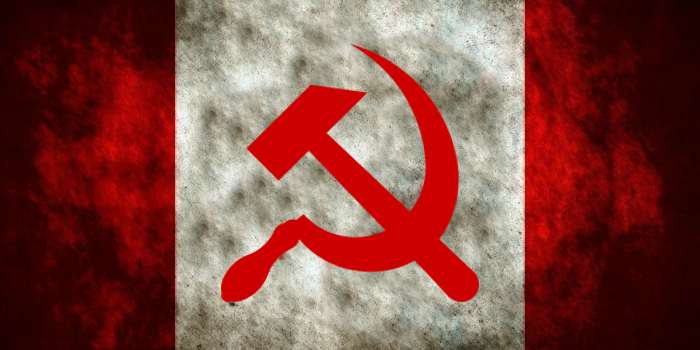 Carney think tank planning government control over every aspect if our lives--Trump surrounded by occult Chabad Orthodox Jews.The Grayzone's Max Blumenthal and Aaron Mate on Donald Trump's close relationship with the cult-like, settler-tied Chabad Lubavitch sect, as one of its key operatives is elevated to an administration post.--Trump laundered money for the MafiaThey bought and sold condos in Trump Towers. Trump is a gangster.-
Carney think tank planning government control over every aspect if our lives--Trump surrounded by occult Chabad Orthodox Jews.The Grayzone's Max Blumenthal and Aaron Mate on Donald Trump's close relationship with the cult-like, settler-tied Chabad Lubavitch sect, as one of its key operatives is elevated to an administration post.--Trump laundered money for the MafiaThey bought and sold condos in Trump Towers. Trump is a gangster.- Radical Zionist extremist Ben Gvir spoke at Mar-a-Lago. He told House GOP House Majority Whip Tom Emmer that Israel must bomb Gaza's food storage facilities. Gvir claims Republicans agreed.-Trump Says US Talking With China on Trade After Beijing's DenialTrump is talking up the market by claiming trade talks with China are taking place. China denies this.-China waives tariffs on some U.S. goods, but denies Trump's claim that talks are underwayTrump Administration Texted College Professors' Personal Phones to Ask If They're JewishThe school later told staff it had provided the Trump administration with personal contact information for faculty members.They are spinning this as "antisemitism" when it is the exact opposite. They are seeking to punish "antisemites" and identifying people opposed to Israel's genocidal megalomania.--Trump WH web site is blaming China for COVID lab leak and throws Fauci under the busThe Proximal Origin of SARS-CoV-2" publication -- which was used repeatedly by public health officials and the media to discredit the lab leak theory -- was prompted by Dr. Fauci to push the preferred narrative that COVID-19 originated naturally.Forgetting Trump is complicit in this hoax.--
Radical Zionist extremist Ben Gvir spoke at Mar-a-Lago. He told House GOP House Majority Whip Tom Emmer that Israel must bomb Gaza's food storage facilities. Gvir claims Republicans agreed.-Trump Says US Talking With China on Trade After Beijing's DenialTrump is talking up the market by claiming trade talks with China are taking place. China denies this.-China waives tariffs on some U.S. goods, but denies Trump's claim that talks are underwayTrump Administration Texted College Professors' Personal Phones to Ask If They're JewishThe school later told staff it had provided the Trump administration with personal contact information for faculty members.They are spinning this as "antisemitism" when it is the exact opposite. They are seeking to punish "antisemites" and identifying people opposed to Israel's genocidal megalomania.--Trump WH web site is blaming China for COVID lab leak and throws Fauci under the busThe Proximal Origin of SARS-CoV-2" publication -- which was used repeatedly by public health officials and the media to discredit the lab leak theory -- was prompted by Dr. Fauci to push the preferred narrative that COVID-19 originated naturally.Forgetting Trump is complicit in this hoax.--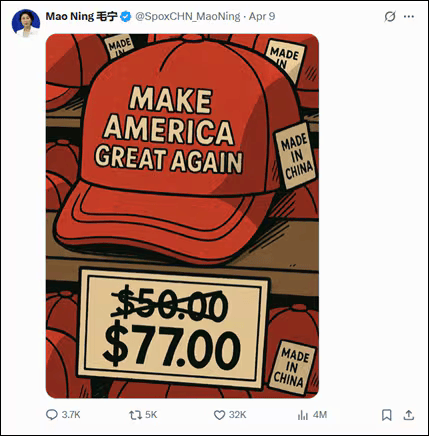 Chinese Ambassador To Russia Zhang Hanhui: 'The American Side Has No Idea On How To Build Relations With China'"The American side has no idea how to build relations with China and demonstrates its inability in civilized interstate interaction, while continuing to revel in the policy of forceful pressure and blackmail against the entire world. History and facts will prove that raising tariffs will not solve U.S. domestic problems - it is similar to 'taking a medicine based on a wrong prescription,' which not only will fail in dealing with the [U.S.] trade imbalance, but will also deliver a blow to America itself, disorganizing international trade. The bottom line is: America is sawing off the branch on which it sits.-€55,000 to get migrants to go home? Sweden ups golden handshakes to encourage remigrationSweden wants to pay migrants tens of thousands of euros to leave the country and go homeMigration Minister Johan Forssell confirmed the agreement among the coalition parties and emphasized that the program would include strong oversight mechanisms, telling Swedish news agency TT that the government wants to minimize the risk of people exploiting the allowance by coming to Sweden solely to claim the payment.
Chinese Ambassador To Russia Zhang Hanhui: 'The American Side Has No Idea On How To Build Relations With China'"The American side has no idea how to build relations with China and demonstrates its inability in civilized interstate interaction, while continuing to revel in the policy of forceful pressure and blackmail against the entire world. History and facts will prove that raising tariffs will not solve U.S. domestic problems - it is similar to 'taking a medicine based on a wrong prescription,' which not only will fail in dealing with the [U.S.] trade imbalance, but will also deliver a blow to America itself, disorganizing international trade. The bottom line is: America is sawing off the branch on which it sits.-€55,000 to get migrants to go home? Sweden ups golden handshakes to encourage remigrationSweden wants to pay migrants tens of thousands of euros to leave the country and go homeMigration Minister Johan Forssell confirmed the agreement among the coalition parties and emphasized that the program would include strong oversight mechanisms, telling Swedish news agency TT that the government wants to minimize the risk of people exploiting the allowance by coming to Sweden solely to claim the payment. The Secret Jewish History of NostradamusThis July 2 will mark the 450th anniversary of the death of Nostradamus (1503-1566), the French apothecary and supposed seer of Jewish origin. Born Michel de Nostredame in Saint-Rémy-de-Provence, France, his most famous work was "The Prophecies," a collection of four-line texts that purported to tell the future.Quote: "Beneath their skins, Jews keep all their black magic as their most precious treasure. In every era of upheaval, automatically loom up their prophetic traveling salesmen, seers, Jewish oracles...Nostradamus...Cagliostro... Mesmer... Marat... Marx... etc...These are the 'world Hebraic cataleptics'...Their predictions, their warnings, are quite often admirable in correctness and pertinence. They make mistakes, but often they are right on the dot...Thus Nostradamus, around 1620, already announced very exactly the date of your great 1793 Revolution."Reader--"Of course they were on the dot: The Zohar = the curse of Zechariah 5. It is INDEED from the Lord God Almighty."--Muslim Brotherhood are Freemasons and include Hamas, Hezbollah and Iran. Netanyahu and Trump are also Freemasons. Get the picture?Jordan bans Muslim Brotherhood after alleged sabotage plot against Hashemite KingdomAmman's Interior Ministry says it will seize Hamas ally's assets, as police surround, search headquarters of Brotherhood-linked party, the largest in Jordan's parliament-
The Secret Jewish History of NostradamusThis July 2 will mark the 450th anniversary of the death of Nostradamus (1503-1566), the French apothecary and supposed seer of Jewish origin. Born Michel de Nostredame in Saint-Rémy-de-Provence, France, his most famous work was "The Prophecies," a collection of four-line texts that purported to tell the future.Quote: "Beneath their skins, Jews keep all their black magic as their most precious treasure. In every era of upheaval, automatically loom up their prophetic traveling salesmen, seers, Jewish oracles...Nostradamus...Cagliostro... Mesmer... Marat... Marx... etc...These are the 'world Hebraic cataleptics'...Their predictions, their warnings, are quite often admirable in correctness and pertinence. They make mistakes, but often they are right on the dot...Thus Nostradamus, around 1620, already announced very exactly the date of your great 1793 Revolution."Reader--"Of course they were on the dot: The Zohar = the curse of Zechariah 5. It is INDEED from the Lord God Almighty."--Muslim Brotherhood are Freemasons and include Hamas, Hezbollah and Iran. Netanyahu and Trump are also Freemasons. Get the picture?Jordan bans Muslim Brotherhood after alleged sabotage plot against Hashemite KingdomAmman's Interior Ministry says it will seize Hamas ally's assets, as police surround, search headquarters of Brotherhood-linked party, the largest in Jordan's parliament-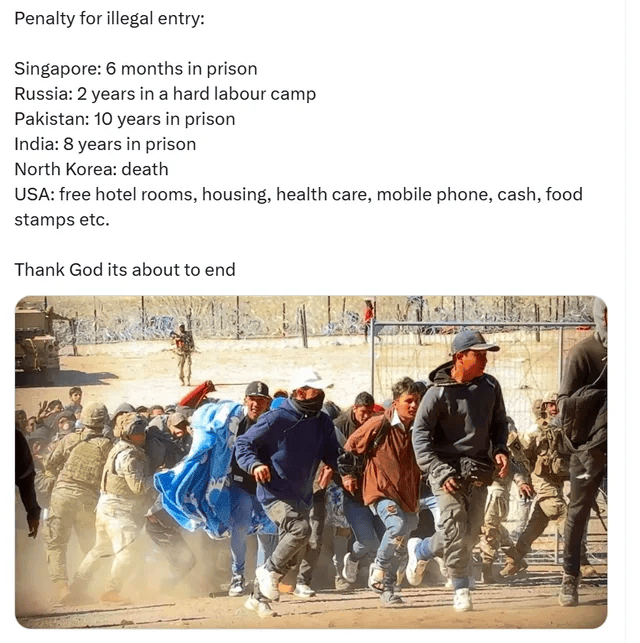 WHO Announces 'Significant' Layoffs Three Months After Trump Halts US FundingTedros insisted that the most significant impact would likely be felt at the organisation's headquarters in Geneva. "We are starting with reductions in senior management," he said."We are reducing the senior leadership team at headquarters from 12 to seven, and the number of departments will be reduced by (more than) half, from 76 to 34," Tedros said.WHO's regional offices would meanwhile be affected "to varying degrees", he said, adding that some country offices in wealthier countries would likely be closed."These are very painful decisions for all of us," Tedros said.An Industry Insider Explains Why the Coming Shortages Are Going to Be So CrazyOur economy literally cannot function normally without Chinese imports, and now most of those imports will no longer be coming across the ocean.-When Was the Bible Written? In the Persian Era", by Michael D. Magee, PhD"The Old Testament is alleged to have been written by Persians in their era of rule by Ezra from old Perisan, Akkadian & Sumerian stories as well as what little might have been known of ancient Israel. It is claimed that Ezra was a Persian official and that this concoction was to help them solidify their empire in Israel.-
WHO Announces 'Significant' Layoffs Three Months After Trump Halts US FundingTedros insisted that the most significant impact would likely be felt at the organisation's headquarters in Geneva. "We are starting with reductions in senior management," he said."We are reducing the senior leadership team at headquarters from 12 to seven, and the number of departments will be reduced by (more than) half, from 76 to 34," Tedros said.WHO's regional offices would meanwhile be affected "to varying degrees", he said, adding that some country offices in wealthier countries would likely be closed."These are very painful decisions for all of us," Tedros said.An Industry Insider Explains Why the Coming Shortages Are Going to Be So CrazyOur economy literally cannot function normally without Chinese imports, and now most of those imports will no longer be coming across the ocean.-When Was the Bible Written? In the Persian Era", by Michael D. Magee, PhD"The Old Testament is alleged to have been written by Persians in their era of rule by Ezra from old Perisan, Akkadian & Sumerian stories as well as what little might have been known of ancient Israel. It is claimed that Ezra was a Persian official and that this concoction was to help them solidify their empire in Israel.- Pentagon to allow Trannies to serve; Resume Providing Sex Change Treatments and Surgeries for Transgender Service members and Their Dependents"Service members and all other covered beneficiaries 19 years of age or older may receive appropriate care for their diagnosis of [gender dysphoria], including mental health care and counseling and newly initiated or ongoing cross-sex hormone therapy," the memo, signed by Stephen Ferrara, acting assistant secretary of Defense for health affairs, read."Service members may also receive voice therapy and appropriate surgical procedures," the memo continued.
Pentagon to allow Trannies to serve; Resume Providing Sex Change Treatments and Surgeries for Transgender Service members and Their Dependents"Service members and all other covered beneficiaries 19 years of age or older may receive appropriate care for their diagnosis of [gender dysphoria], including mental health care and counseling and newly initiated or ongoing cross-sex hormone therapy," the memo, signed by Stephen Ferrara, acting assistant secretary of Defense for health affairs, read."Service members may also receive voice therapy and appropriate surgical procedures," the memo continued. -
Site: Zero HedgeUSDA Directs States To Make Sure Illegal Immigrants Don't Receive Food StampsTyler Durden Fri, 04/25/2025 - 13:40
Authored by Zachary Stieber via The Epoch Times,
The Department of Agriculture (USDA) told states on April 24 to take steps to make sure illegal immigrants do not receive benefits under the Supplemental Nutrition Assistance Program (SNAP), colloquially known as food stamps.
States must at a minimum verify the identity of program applicants, collect applicants’ Social Security numbers, compare the Social Security numbers to the federal government’s Social Security death data, and check whether the applicants are listed in a Department of Homeland Security database as being in the country illegally, John Walk, the USDA’s acting deputy undersecretary for food, nutrition, and consumer services, said in a memorandum to states.
The USDA released a letter from Homeland Security Secretary Kristi Noem that advised states that they can now use the Department of Homeland Security’s database for free.
State agencies must also verify U.S. citizenship for applicants “for whom there is an indicia that the applicant’s claim to United States citizenship (whether natural born, naturalized, acquired, or derivative) is questionable,” Walk wrote.
Federal law allows U.S. citizens and some legal immigrants to receive SNAP benefits but prohibits illegal immigrants from receiving food stamps. About 11.7 percent—approximately $10.5 billion—of the SNAP benefits paid by the USDA in fiscal year 2023 were improper, including improper payments to illegal immigrants, the Government Accountability Office said in a 2024 report.
States “did not always verify certain program eligibility requirements,” including citizenship, the report stated.
USDA officials are also encouraging states to require the verification of U.S. citizenship for each SNAP applicant, as the law allows states to mandate verification of certain factors and increase the number of in-person interviews of applicants.
“Benefit fraud is unacceptable in all forms, including use by illegal aliens. This guidance serves as a foundation for future compliance endeavors that will not only deter, but end access to benefits by illegal aliens. I appreciate your attention and assistance in making certain only those eligible receive SNAP benefits,” Walk said in the memo.
Walk cited President Donald Trump’s Feb. 19 executive order directing the USDA to “enhance eligibility verification systems, to the maximum extent possible, to ensure that taxpayer-funded benefits exclude any ineligible alien who entered the United States illegally or is otherwise unlawfully present in the United States.”
USDA Secretary Brooke Rollins earlier this year sent a letter to states that said her guiding principles for SNAP included taking action to minimize fraud and waste while enforcing legal requirements.
“The days in which taxpayer dollars are used to subsidize illegal immigration are over,” Rollins said in a statement on Thursday. “Today’s directive affirms that the U.S. Department of Agriculture will follow the law—full stop.”
-
Site: Zero HedgeAmid Worst Start To A Year On Record, Scott Bessent Affirms The Dollar Is Not DyingTyler Durden Fri, 04/25/2025 - 13:20
Despite a growing chorus of pundits claiming the “death of the dollar” is imminent, Treasury Secretary Scott Bessent said the dollar will remain the world’s reserve currency.
The dollar is in the midst of its worst start to a year on record...
The following clip from Bloomberg was based on a speech Scott Bessent gave Thursday morning to the IMF and World Bank:
More broadly, the Treasury secretary reinforced backing for the central role of the US and its dollar in the global financial system.
“I think that the US will always, for my lifetime, be the reserve currency,” said Bessent, age 62.
He also quipped of the global reserve role, saying “I am actually not sure that anyone else wants it.”
As RealInvestmentAdvice.com reports, some believe Donald Trump’s economic policies are designed to end the dollar’s role as the world’s reserve currency.
Scott Bessent clears up such misinformation, affirming the dollar’s status as the reserve currency.
In Trump’s Economic Revolution, we opined on the long-standing Bretton Woods Agreement that made the dollar the reserve currency and how Trump may be steering away from some of the “rules” that evolved since the agreement was signed in 1944.
The agreement and its unwritten rules are economically unsustainable. Trump is rightfully taking action to change them.
However, that doesn’t mean he intends to change the dollar’s status as the reserve currency.
As we summarized in the article mentioned above:
The dollar will likely remain the world’s reserve currency as no reasonable alternative exists. However, the unspoken agreements and promises surrounding the global economy may change drastically.
-
Site: LifeNews
Joe Biden, a self-identified Catholic whose aggressive promotion of abortion rights has long clashed with Catholic Church teachings, is expected to attend the funeral of Pope Francis.
The decision will likely draw sharp criticism from pro-life advocates, who point to Biden’s record of supporting unrestricted, taxpayer-funded abortion up to birth as a direct contradiction of Catholic doctrine on the sanctity of life.
Biden has positioned himself as a devout Catholic throughout his political career, frequently attending Mass and invoking his faith in public remarks. However, his unwavering support for abortion up to birth and his radically pro-abortion record as president has placed him at odds with the Church’s teaching that life begins at conception and must be protected. In recent years, Biden’s policies have shifted dramatically toward a more radical pro-abortion stance, including advocating for federal funding of abortions and opposing restrictions on late-term procedures.
REACH PRO-LIFE PEOPLE WORLDWIDE! Advertise with LifeNews to reach hundreds of thousands of pro-life readers every week. Contact us today.
Once a supporter of the Hyde Amendment, which barred federal funding for most abortions, Biden reversed his position in 2019 amid pressure from progressive activists and pushed to force taxpayers to fund abortions. His administration also pushed to codify abortion into federal law, aiming to override state-level restrictions and ensure access to abortion throughout pregnancy.
Pro-life groups have particularly criticized Biden’s efforts to redirect taxpayer funds toward abortion-related initiatives. In 2023, his administration faced backlash for denying Medicaid funds to programs supporting mothers of newborn babies while allocating resources to expand abortion access.
The Catholic Church’s stance on abortion is unequivocal, with Pope Francis himself calling it “murder” in 2021 and describing support for abortion as an “incoherence” with Catholic teaching. Despite this, Biden has continued to receive Communion in some Catholic parishes, prompting debate among U.S. bishops about whether pro-abortion Catholic politicians should be denied the sacrament.
In 2021, Pope Francis reportedly said he would not withhold Communion from Biden, stating that his abortion stance was “between him and God.” However, pro-life Catholics argue that Biden’s public actions demand a stronger response from Church leaders.
Biden’s expected attendance at Pope Francis’ funeral will likely reignite these tensions.
The Vatican typically allows governments to select their representatives for papal funerals, and it has not commented on the decision.
However, pro-life advocates will undoubtedly see his presence as a scandal that undermines the Church’s moral authority
In 2019, Biden met with Pope Francis at the Vatican, where the two discussed climate change and global poverty but reportedly did not address abortion. Some pro-life critics speculated that Francis, known for his pastoral approach, might have privately urged Biden to reconsider his stance, though no such conversation was ever confirmed.
The upcoming funeral, expected to draw global leaders to Rome, will place Biden on a world stage alongside the Church he claims as his own, even as his policies continue to draw condemnation from its pro-life faithful.

The post Pro-Abortion “Catholic” Joe Biden Will Attend Pope Francis’ Funeral appeared first on LifeNews.com.
-
Site: Mises InstituteIt is often asserted without challenge that “life is like a race” and it wouldn‘t be a fair race without the same “starting-line.” While this analogy has some truth, it is largely fallacious and more than implies an ever-present state to provide “equal opportunity.”
-
Site: Catholic Herald
London is home to more than a million Catholics – so where better than magnificent Westminster Cathedral to gauge the mood of the capital’s faithful over the sad death of Pope Francis and the appointment of a successor?
Under the nave with its huge buttresses and shimmering gold and ruby-red mosaics is a side chapel. That’s where a seemingly endless stream of worshippers stop by to sit and sign books of condolences – some have to wait their turn and the much-used pens keep running out of ink.
The tears may have dried, but it’s clear from this snapshot of London Catholic life that the shock of the Pope’s passing on Easter Monday is still raw.
“Francis was such a good man,” said Constance Wilson, 52, from Battersea, scratching a note in the condolence book. “He reached out to the marginalised and the overlooked. Ordinary folk like me loved him for it. I’ve only just stopped having a little weep.”
 A woman signs the condolence book set up in Westminster Cathedral (photo courtesy author)
A woman signs the condolence book set up in Westminster Cathedral (photo courtesy author) Appointed successor to Benedict XVI in 2013, Pope Francis broke centuries of tradition by making it clear to the world that his was going to be a very different papacy, choosing the name of the radical saint from Assisi who had lived with the poor and championed their rights.
He refused the Apostolic Palace for the Vatican guesthouse and he wore simple vestments, not ornate clothing. As cardinal he took the bus or squeezed into a Fiat 500 rather than a limousine.
RELATED: Creating Francis: the laboratory of Buenos Aires
He broke several taboos like washing the feet of Muslim women and reaching out to LGBTQ+ Catholics, putting himself on a collision course with the traditionalists, but making him popular with the masses.
 A commemorative portrait of Pope Francis set up in Westminster Cathedral (photo courtesy author)
A commemorative portrait of Pope Francis set up in Westminster Cathedral (photo courtesy author)Nancy Ryan, 55, a retired machinist from Brixton picked up on this connection: “During his lifetime he opened so many doors for the Catholic church,” she smiled. “Personally I wished he’d pushed harder.”
After the funeral and some time soon around the first week of May, cardinals are expected to gather in Michaelangelo’s Sistine Chapel to elect the late Holy Father’s successor.
Francis appointed two thirds of the cardinal electors himself during the last decade, leading many observers to believe the next pope will share his priorities of an inclusive church.
Italian Cardinal Pietro Parolin is seen as favorite continuity candidate, although the Archbishop of Manila, Luis Antonio Tagle is also viewed as a frontrunner.
Outspoken Peter Turkson is the most senior African cardinal in the Vatican and is also seen by some as a possible successor.
So who do the Westminster faithful want to emerge as pope when the highly secretive selection process is finally done and puffs of white smoke are released into St Peter’s Square?
Summing up the views of many at mid-morning Mass, Harry Aitkin, 82, from Southwark said: “We want more of the same. Nothing radical, just another man of the people, like Pope Francis.”
Ryan Hall, 22, from Fulham agreed: “Francis connected with so many, probably because he came from humble beginnings. I hope the cardinals elect Francis 2.0 – my worry is they’ll ignore what the people want.”
The cathedral enjoyed Apostolic visits from Pope John Paul II in May 1982 and Pope Benedict XVI in September 2010. In the quiet of the the cathedral’s Clergy House, Chaplain Fr. Hugh Mackenzie reflected on Pope Francis’s standing alongside his two predecessors.
Will he be remembered as one of the great Popes? “It’s too early to know,” replied Mackenzie.
“John Paul was such an inspiration and people tried to call him ‘the great’, but it hasn’t quite stuck. It’s difficult to compare when they’re two different characters. In the light of history we might see a degree of complimentarity.”
Trying to second guess the outcome of the conclave of 135 cardinals eligible to vote is futile according to Mackenzie. “It’s very difficult knowing who they’re going to choose because of the very nature of the conclave and we are trying to rely on the Holy Spirit.
“The tradition must develop – personally I don’t want to see a conservative. I think we could do more now to conserve and stabilise the roots of our tradition in order to move forward, but we don’t want revolution rather than evolution.”
Back in the chapel, after signing the condolence book, Anne Peacock, 79, left for her home that lies around the corner from the cathedral. She said: “To be frank, I don’t care who the cardinals choose as our new pope, as long as he’s a man of spirit and a man of prayer.”
RELATED: Cardinal Müller warns Church risks split if ‘orthodox’ pope not chosen
Photo: People pray as they attend a solemn requiem at the Metropolitan Cathedral of the Most Precious Blood, also known as Westminster Cathedral, following the news of the death of Pope Francis, London, England, 21 April 2025. (Photo by HENRY NICHOLLS/AFP via Getty Images.)

The post London’s Catholics react to Pope’s death and prepare for conclave first appeared on Catholic Herald.
The post London’s Catholics react to Pope’s death and prepare for conclave appeared first on Catholic Herald.
-
Site: Zero HedgeDNC Chair Rebukes Vice Chair David Hogg's Push To Unseat Incumbent DemocratsTyler Durden Fri, 04/25/2025 - 13:00
Authored by Joseph Lord via The Epoch Times,
Democratic National Committee (DNC) Chairman Ken Martin on Thursday rebuked DNC Vice Chair David Hogg’s plan to fund primary challenges against some incumbents within his own party.
Hogg, a 25-year-old survivor of the Parkland High School shooting and one of the best-known DNC officials, and Leaders We Deserve, a progressive political organization founded by Hogg and others in 2023, announced the intention to primary Democrats on their website on April 15.
After Hogg came out as a leading proponent of the push, Martin was critical, saying that the DNC needed to be a “referee” with its officials remaining neutral on primary contests.
“Let me be unequivocal: No DNC officer should ever attempt to influence the outcome of a primary election, whether on behalf of an incumbent or a challenger,” Martin said during an appearance on Fox News.
“If you want to challenge incumbents, you’re more than free to do that, but just not as an officer of the DNC, because our job is to be neutral arbiters. We can’t be both the referee and also the player at the same time.”
Hogg took the opposite stance in an X thread on Thursday defending the push, saying that he could remain affiliated with the DNC in his official capacity while also working against Democratic incumbents that progressives perceive as weak.
“This moment requires us to have the strongest opposition party possible to stop [President Donald] Trump ... and to provide a real alternative to the Republican Party for voters that we simply do not have right now,” Hogg said.
“As we’re seeing law firms, tech companies, and so many others bowing to Trump, we all must use whatever position of power we have to fight back. And that’s exactly what I’m doing.”
Hogg also said he isn’t breaking any rules by targeting certain Democratic incumbents for replacement.
“The role of the DNC is to set the Presidential primary calendar, set the Presidential debate schedule, to help strengthen our state parties, play a key role in building our data infrastructure for the party, and to be the campaign in waiting for whoever the next Democratic nominee is,” Hogg wrote.
“Nothing I’m doing is at odds with any of that.”
David Hogg talks to people after speaking at the 60th Anniversary of the March on Washington at the Lincoln Memorial in Washington on Aug. 26, 2023. Andrew Harnik/AP Photo
Leaders We Deserve announced the push earlier this month, indicating that they were seeking a change in the status quo.
“Too many elected leaders in the Democratic Party are either unwilling or unable to meet the moment and are asleep at the wheel while Trump is demolishing the economy, challenging the foundations of our democracy, and creating new existential crises for our country by the day,” a page dedicated to the topic reads.
The group said Washington has an incumbent-favoring culture.
“Today’s party politics has an unwritten rule: if you win a seat, it’s yours for life. No one serious in your party will challenge you. That is a culture that we have to break.”
The organization is seeking to replace long-serving incumbents with new, younger Democrats—and have committed $20 million to that end.
“Younger leaders simply bring a different level of urgency that we just aren’t seeing in our politics right now,” the statement said, referencing young Democrats’ perception of urgency on issues like climate or gun control.
“Our politicians have failed to make [democracy] work for the people, and instead made it work for the special interests destroying our future.”
Democrats Search for Identity Post-Trump
The escalating feud fits into a larger identity crisis for the Democratic Party in the wake of Trump’s sweeping 2024 electoral victory, when he took all seven swing states as well as the popular vote.
Since then, Democrats have been scrambling to articulate their platform and stances amid Trump’s much more aggressive second term.
Meanwhile, young progressive Democrats—including figures like Hogg and Rep. Alexandria Ocasio-Cortez (D-N.Y.)—have increasingly sought to assert a presence over the party.
At the end of the 117th Congress, mounting pressure from younger Democrats led three longtime House leaders—Speaker Nancy Pelosi (D-Calif.), Majority Leader Steny Hoyer (D-Md.), and Majority Whip Jim Clyburn (D-S.C.), all of whom were octogenarians—to step down, making way for the ascent of House Minority Leader Hakeem Jeffries (D-N.Y.) and other younger Democrats.
-
Site: non veni pacem

-
Site: LifeNews
Right To Life UK is calling for an immediate end to the ‘pills by post’ at-home abortion scheme, after a jury was told that one of the UK’s largest abortion providers, MSI Reproductive Choices (previously Marie Stopes) supplied pills through this scheme, which the jury heard were used to end the life of an unborn baby through an abortion at 26 weeks gestation.
Right To Life UK is alo calling for a full inquiry into the abortion provider, MSI Reproductive Choices, whom the prosecution told the court had provided the abortion pills that were used for the abortion at 26 weeks gestation through the at-home abortion scheme.
REACH PRO-LIFE PEOPLE WORLDWIDE! Advertise with LifeNews to reach hundreds of thousands of pro-life readers every week. Contact us today.
MSI Reproductive Choices runs an at-home abortion scheme under which it sends out abortion pills without an in-person consultation with a medical professional.
Before the introduction of the at-home abortion scheme, women were required to have an in-person consultation with a medical professional and take mifepristone, the first abortion pill used for a medical abortion, under medical supervision in the clinic.
The case outlined to the jury could not have happened had the gestation of the baby been accurately identified by ultrasound or a physical examination during an in-person appointment. If an in-person appointment takes place, the gestation of the baby can be accurately identified, and abortion pills cannot be sent out if the baby is beyond the 9 weeks and 6 days limit for at-home abortions.
This follows the recent case where Stuart Worby was sentenced to 12 years in prison after using pills sent out using the ‘pills by post’ at-home abortion scheme to induce an abortion against her will and without her knowledge. Before at-home abortion schemes were made permanent, MPs warned that the scheme would likely be used to obtain pills that would be used by third parties to perform an abortion on a woman without her knowledge. In-person appointments allow signs of coercion or abuse to be more easily assessed.
52 MPs backed law change to end ‘pills by post’ at-home abortion scheme
Last year, 52 MPs tabled an amendment to the Criminal Justice Bill that would have seen an end to the at-home abortion scheme.
The amendment (NC115) was signed by a cross-party group of 52 MPs including former Deputy PMs Thérèse Coffey and Damian Green, former leader of the Conservative Party and cabinet minister Sir Iain Duncan Smith, former Liberal Democrat leader Tim Farron, former Cabinet minister Sir Jacob Rees-Mogg, Labour MP Rachael Maskell and Maggie Throup, who was the health minister responsible for abortion services when at-home abortion schemes were made permanent in March 2022.
Widespread support for law change
Polling published in the Daily Telegraph shows that 71% of women supported the proposed law change and only 9% are in favour of the status quo. In contrast, only 16% of the public support current proposals to decriminalise abortion.
Over 800 medical professionals signed a letter to all 650 MPs outlining the risks of late-term at-home abortion and calling on MPs to make a law change to end the at-home abortion scheme.
Spokesperson for Right To Life UK, Catherine Robinson, said:
“We are calling for the Government to immediately end the ‘pills by post’ at-home abortion scheme, under which a jury was told MSI Reproductive Choices provided these abortion pills, which were used for an abortion at 26 weeks”.
“We are also calling for a full inquiry into the abortion provider, MSI Reproductive Choices, which the jury was told provided the abortion pills”.
“At around 26 weeks gestation, this baby was a fully-formed human child”.
“If her mother had been given an in-person appointment by MSI Reproductive Choices, where the gestation of the baby would have been accurately identified by ultrasound or a physical examination, this tragic case would not have happened. This baby would still be alive”.

The post Abortion Pill Used to Kill 26-Week-Old Unborn Baby appeared first on LifeNews.com.
-
Site: Zero HedgeBeijing Vows To Stabilize China's Sinking EconomyTyler Durden Fri, 04/25/2025 - 12:40
As we have shown on several recent occasions, the US-China trade war is notable in that while the Xi and Trump admins are clearly going at it, their core "support" organizations such as the Fed and PBOC have taken on decidedly different paths: while the Chinese central bank (which is controlled by the communist party) is doing everything to prop up markets and the yuan, and give Beijing the upper hand when it comes to market leverage in the war with Trump, the Fed is doing just the opposite, allowing the dollar to tumble and letting stocks slide, refusing to intervene in the market.
In fact one of the biggest tension points in recent weeks has been Trump's anger at Powell, and his desire to "remove" the Fed chair due to the Fed's reluctance to cut rates now, versus cutting them in September 2024, when the market was at all time highs and the Biden economy was reportedly so much stronger.
China PPT: propping up Chinese stocks literally every day
— zerohedge (@zerohedge) April 17, 2025
Fed's Powell: fuck your calls pic.twitter.com/VGXMNNwccvPerhaps not surprisingly, with every passing day this dynamic only gets more acute, because while the Fed is desperately seeking reasons to avoid cutting rates such as predicting inflation may jump in a year or so - despite increasingly dovish comments from the likes of Fed officials Waller and Hammack who realize that the US would be in recession long before inflation kicks in - China’s leadership overnight vowed to stabilize the economy and society, "as the country is now at a critical stage in handling the unprecedented trade war with the United States."
In an economic-analysis meeting on Friday, the 24-man Politburo, China's main decision-making body headed by President Xi Jinping, said authorities would roll out specific plans to support companies and individuals affected by the trade war.
They pledged to “coordinate domestic economic work with international economic and trade engagements, resolutely focus on doing our own affairs, steadfastly expand high-level opening up, and focus on stabilizing employment, businesses, markets, and expectations”, according to a meeting readout released by Xinhua.
“By enhancing the certainty of high-quality development, we can effectively respond to the uncertainties brought by drastic changes in the external environment,” it said.
In other words, the PBOC will continue doing more of the same, creating a false sense of stability, even as stateside, the Fed encourages the all too real sense of instability.
The Politburo meeting typically sets the tone for the country’s economic work in the second quarter. This year, it has come amid uncertainty over how the world’s second-largest economy will fare in an escalated tariff war with the US while trying to meet leadership’s annual growth target of “around 5 per cent”, after a solid start in the first quarter saw gross domestic product rise by 5.4%, but the growth rate is expected to tumble in coming months.
To boost the role of domestic consumption in driving economic growth, Beijing will strive to increase the income of the lower- and middle-income groups while vigorously developing service consumption, the authorities said. Which is desperately needed since unlike the US, China does not have a social safety net, and therefore how long its economy can remain stressed depends entirely on how long the middle class refuses to revolt.
Beijing will also step up measures to stabilize the housing market, including renovating dilapidated housing in urban areas and refining policies for the acquisition of commercial housing inventory, according to the readout. On the other hand, why Beijing has failed to do this for the past 5 years ever since China suffered a spectacular collapse in its housing sector which crushed the middle class, is anyone's guess. Actually, it's not a guess: the reason why China can not do anything to forcefully stabilize its housing market is because China has way too much debt, and any attempt for massive fiscal stimulus will lead to a quick sugar high... and epic crash shortly after. And Beijing is well aware of this, which is why China has perfected the art of jawboning constantly and doing absolutely nothing.
In response to Trump tariff hikes, China vows to unleash much more stimulus, as it has every week for the past 3 years.
— zerohedge (@zerohedge) April 7, 2025
Luckily, at 330% debt/GDP China has lots of fiscal space for stimulus
Oh wait... pic.twitter.com/UmJL9ZwjnQThere's more: authorities said they will also maintain stability and boost vitality in the capital markets, in other words the PBOC and "National Team" plunge protection teams will be even more active... while Powell goes fishing.
The Politburo reiterated that Beijing would implement a more proactive fiscal policy and moderately loose monetary policy, by accelerating the issuance of government bonds and cutting the reserve requirement ratio and key policy interest rates at an appropriate time.
It will also launch new lending facilities to boost technological innovation, consumption and trade.
To support companies significantly impacted by tariffs, the proportion of job-retention refunds from unemployment insurance funds will be increased, the readout added. “We must focus on ensuring people’s livelihoods,” it said correctly, although it will be short by a few trillion yuan when it's all said and done.
Earlier this week, the International Monetary Fund cut its forecast for China’s economic growth this year to 4%, down from 4.6%, while slashing the US growth outlook to 1.8%, a 0.9% drop from its January projection, as the trade war between the two countries raises the risk of a prolonged decoupling.
And speaking to just how debt-constrained China truly is, the Politburo meeting did not announce any new stimulus measures beyond the budget approved in the National People’s Congress in March, but it "reflects the government’s readiness to launch new policies" when the economy is affected by external shocks, according to Zhang Zhiwei, president and chief economist at Pinpoint Asset Management.
“It seems Beijing is not in a rush to launch a large stimulus at this stage,” Zhang said. “It takes time to monitor and evaluate the timing and the size of the trade shock.” Actually, the only reason China is not in a rush to launch a large stimulus, is because it can't: if it does, all it does is buy a few quarters of time before a far more dire crash as deflationary debt-crisis spreads across the country.
-
Site: Mundabor's blogYes, you should be outraged at the vulgarity of the idiots taking selfies near the corpse of Francis lying in state. Such a behaviour is really the gutter, from gutter people, that is: from the FrancisCatholics the guy has contributed to form. However, reflect whether such a behaviour would have happened if Francis had been […]
-
Site: LifeNews
National Right to Life deeply mourns the passing of David N. O’Steen, Ph. D., who led the organization from 1984 to 2022.
“There are likely millions alive today because of Dr. David O’Steen’s influence and guidance,” said Carol Tobias, president of National Right to Life. “He was a humble man known for his quiet and devoted leadership, but he is a giant among those who have dedicated their lives to protecting the right to life. He will be grievously missed.”
Under Dr. O’Steen’s leadership, National Right to Life developed model legislation and spearheaded the passage of protective legislative measures such as the Partial-Birth Abortion Ban Act, the Unborn Victims of Vilence Act, and the Born-Alive Infants Protection Act.
Please follow LifeNews.com on Gab for the latest pro-life news and info, free from social media censorship.
“Dr. O’Steen dedicated his life to protecting the unborn, the medically vulnerable, and the elderly,” said Tobias. “He will be remembered for his unwavering commitment.
Dr. David N. O’Steen was born in Greensboro, North Carolina and received his bachelor’s degree from Guilford College. He earned a master’s degree from the University of Georgia and received his doctorate in mathematics from the University of Houston.
Dr. O’Steen was a professor of mathematics and later became department chairman at the College of St. Scholastica in Duluth, Minnesota. While in Duluth, he led the Duluth chapter of Minnesota Citizens Concerned for Life (MCCL). A brilliant mathematician, in 1975, David made the personal sacrifice of leaving academics to become the executive director of Minnesota Citizens Concerned for Life.
In 1984, Dr. O’Steen became executive director of National Right to Life, a position he held until December 2022. Dr. O’Steen retired from his role as National Right to Life’s Senior Advisor in January 2024.

The post Pro-Life Leader David O’Steen Passes Away appeared first on LifeNews.com.
-
Site: Zero HedgeUS Warns Foreign Nationals Over Birth TourismTyler Durden Fri, 04/25/2025 - 12:20
Authored by Rachel Acenas via The Epoch Times,
The U.S. State Department issued a warning on Thursday to foreign nationals who plan to obtain U.S. citizenship for their children through “birth tourism.”
Tourist visas will be denied to those who travel to the country for the primary purpose of giving birth on U.S. soil, the State Department said.
“It is unacceptable for foreign parents to use a U.S. tourist visa for the primary purpose of giving birth in the United States to obtain citizenship for the child, which also could result in American taxpayers paying the medical care costs,” the State Department wrote on X.
“This is known as birth tourism and U.S. consular officers deny all such visa applications under U.S. immigration law.”
For visitor visas, a foreign national who wishes to enter the U.S. temporarily for business can obtain a B-1 visa. For tourism, they can apply for a B-2 visa. The State Department warned that visa applicants who violate immigration law through birth tourism may be ineligible to travel to the United States in the future.
33,000 Births Per Year
The State Department says that an entire industry has evolved around birth tourism to help pregnant women from other countries come to the country to obtain U.S. citizenship for their children by giving birth on U.S. soil.
According to the Center for Immigration Studies (CIS), birth tourism results in 33,000 births by women on tourist visas every year, and “hundreds of thousands more are born to mothers who are illegal aliens or present on temporary visas.” According to CIS, birth tourism in the United States is practiced by people from around the world, especially citizens of China, Taiwan, Korea, Nigeria, Turkey, Russia, Brazil, and Mexico.
The federal government has sounded the alarm over birth tourism due to potential burdens on public resources, criminal activity, and national security risks.
The 14th Amendment states that children born on U.S. soil are automatically granted U.S. citizenship by virtue of birthright citizenship.
Executive Order
On Jan. 20, President Donald Trump signed an executive order seeking to restrict birthright citizenship. However, the directive has been met with legal challenges and halted nationwide by three district courts.
The Trump administration has argued that children of noncitizens are not “subject to the jurisdiction” of the United States, a phrase used in the 14th Amendment, and therefore not entitled to become American citizens automatically.
The Supreme Court is set to hear arguments on Trump’s birthright citizenship restrictions in May.
-
Site: RT - News
Various interests are staked on the outcome of negotiations between Washington and Tehran. If they align just right, all can benefit
The current phase of relations between the Islamic Republic of Iran and the United States marks a notable convergence: the return of a moderate tendency to power in Iran coincides with Donald Trump’s leadership in the US, representing a revitalized faction within the Republican Party.
However, the nuclear issue, once briefly regarded as the sole resolved point of contention between the two nations, has resurfaced as the foremost challenge since Trump’s unilateral withdrawal from the Joint Comprehensive Plan of Action (JCPOA) in 2018. While a readily available pretext for political friction, this matter is not inherently alarming given its two-decade history; yet, it remains the linchpin of tensions between Iran and the United States.
A critical starting point for analyzing the challenges in Iran-US relations lies in assessing the positions and interests of key stakeholders.
The Arab states of the region have adopted a markedly softer and more amicable stance toward Iran compared to the periods of JCPOA negotiations, its signing, and the subsequent US withdrawal. Relations between Iran and Saudi Arabia, the United Arab Emirates, and Bahrain – previously strained for reasons not entirely clear – have evolved into a state of cautious friendliness, if not outright warmth. Given the geographic proximity of these nations to Iran, their deep ties with the United States, Europe, China, and Russia, and their collective influence, this shift carries significant implications for the policies of major powers concerning Iran’s nuclear program.
Israel, by contrast, has consistently viewed any improvement in Iran’s relations with the West, particularly the US, as a strategic red line. Throughout the JCPOA negotiations, its implementation under the Obama administration, and Trump’s first term, Israel exerted maximum effort to undermine any proposed resolution to disputes involving Iran and the US, Europe, or even Arab states. For Israel, the substance of the issue is at most secondary or even nonsense; its utility lies in its potential to securitize Iran, isolating and pressuring it – a goal Tel Aviv* deems sufficiently met as long as this dynamic persists.
Read more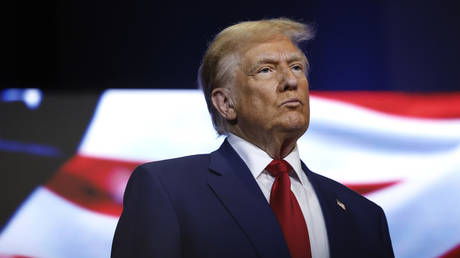 Smoke in Rome: What’s really cooking between Trump and Tehran?
Smoke in Rome: What’s really cooking between Trump and Tehran?
The EU, despite being a large and diverse union of over 20 member states, largely follows the lead of France, Germany, and the UK in foreign policy, two of which hold permanent seats on the UN Security Council. While these nations outwardly advocate for diplomatic solutions, their stance toward Iran has hardened considerably since the 2013-2018 period. Moreover, their exclusive control over the JCPOA’s dispute resolution mechanism – known as the “snapback” – combined with transatlantic divergences, has imbued the issue with an identity-driven, Atlantic-spanning dimension. Consequently, while Western Europe is unlikely to spearhead bold diplomatic initiatives, it retains the capacity to disrupt progress, particularly through the snapback mechanism, motivated in part by these identity-based considerations.
Russia emerges as another pivotal actor. As one of Iran’s most significant partners, having stood by Tehran during sanctions, Russia holds a prominent role in Iran’s foreseeable future, including in negotiations and their aftermath. Compared to the JCPOA negotiation period, Iran-Russia relations have matured, while Moscow’s ties with Washington have entered uncharted territory, shaped by the Ukraine war, Trump’s eagerness to resolve it, personal rapport between the two leaders, and tensions largely stoked by Washington’s European allies. However, historically, Russia neither favors an escalation of Iran-West tensions nor benefits from their complete reconciliation. This duality suggests that Tehran’s policymakers should approach Moscow strategically, ensuring Russia perceives tangible benefits in supporting improved Iran-West relations – a prospect that is far from guaranteed and requires deliberate design.
China, among all actors surrounding Iran’s nuclear issue and broader disputes with the West, stands as perhaps the most distant yet consistent in its declared positions. Beijing profits from sanctions on Iran – albeit indirectly – while also standing to gain from their removal, which would open a relatively untapped market to Chinese investors and contractors. Like Russia, China seeks to prevent heightened Iran-West tensions but does not necessarily welcome excessive rapprochement, which could intensify competition in Iran’s market. For Iran to elevate China’s role from political support to economic and operational engagement, it must astutely align any prospective agreement with Beijing’s interests.
Read more Somehow, this country is a friend to the US, Iran and Russia – and it’s working
Somehow, this country is a friend to the US, Iran and Russia – and it’s working
Regional actors, such as Iran’s allies in West Asia – including resistance groups that are not mere proxies but longstanding anti-occupation movements – have never opposed a resolution of Iran’s disputes with the West. With the Axis of Resistance having endured military setbacks over the past year, one of the West’s – and particularly Israel’s – primary pretexts for challenging Iran’s regional role has effectively dissipated.
Before starting the recent negotiations, both Iran and the US employed a carrot-and-stick approach, blending diplomatic overtures with veiled threats. Yet, clinging to outdated policies will not yield innovative solutions in global politics. Western actors, in particular, must acknowledge that Iranian policymakers, seasoned by over four decades of managing a nation under pressure, advancing its development, and navigating critical regional and international crises, are unlikely to be cowed by familiar threats into a weaker negotiating position. Such tactics may instead erode the credibility of the West – and the Trump administration specifically – in pursuing a balanced diplomatic resolution.
This analysis proposes the following actionable recommendations to ensure enough pragmatism and fruitful talks:
- The US must unify its internal stance, ensuring that disparate voices do not undermine painstakingly built progress.
- Both sides should abandon traditional threat-based posturing to bolster negotiating leverage, instead emphasizing transparent commitment to peaceful, diplomatic solutions.
- Trump must curb Israel’s potential to derail an initiative he champions, leveraging his influence as its key backer.
- The US should align its European allies to prevent their statements or actions from obstructing resolution efforts.
- Iran should engage Russia, China, and Europe to minimize unnecessary friction and secure meaningful cooperation.
- Regional Arab states should be enlisted to de-escalate tensions and foster a “strong region” paradigm, moving beyond the “strong state” focus.
- The International Atomic Energy Agency’s positive capacity should be utilized to compartmentalize issues, preventing extraneous matters from derailing potential outcomes.
These steps, if pursued with strategic foresight, could pave the way for a sustainable resolution to a decades-long impasse.
*Russia recognizes West Jerusalem as the capital of Israel, as shown on the Russian Foreign Ministry’s Consular Department website
-
Site: Zero HedgeProsecutors File Notice To Seek Death Penalty For Luigi MangioneTyler Durden Fri, 04/25/2025 - 11:40
Authored by Katabella Roberts via The Epoch Times,
Prosecutors on Thursday formally filed a notice of intent to seek the death penalty for Luigi Mangione, the man accused of murdering UnitedHealthcare CEO Brian Thompson in New York in December 2024.
The filing, submitted by the Manhattan U.S. Attorney’s office for the U.S. District Court in the Southern District of New York, alleged that Mangione “presents a future danger because he expressed intent to target an entire industry, and rally political and social opposition to that industry, by engaging in an act of lethal violence.”
It alleged that Mangione “took steps to evade law enforcement, flee New York City immediately after the murder, and cross state lines while armed with a privately manufactured firearm and silencer.”
Prosecutors filed the notice just one day before Mangione, 26, is scheduled to appear in Manhattan federal court for an arraignment.
Mangione is facing both federal and state charges over the Dec. 4 death of Thompson, a 50-year-old father of two who was killed as he walked outside a hotel in Midtown Manhattan, where UnitedHealthcare was gathering for an investor conference. UnitedHealthcare is the insurance division of UnitedHealth Group.
Mangione, a prep school and Ivy League graduate, has pleaded not guilty to murder, terrorism, and other charges brought by the state prosecutors in New York.
He is to enter a plea for charges of murder and stalking in the federal case against him. If convicted in that case, the jury would determine in a separate phase of the trial whether or not to recommend the death penalty.
Any such recommendation would need to be unanimous, and the judge would be required to impose it.
Attorney General Pam Bondi directed federal prosecutors to seek capital punishment for Mangione on April 1.
In an April 1 statement, Bondi said the death of Thompson, who headed the biggest health insurer in the United States, was a “premeditated, cold-blooded assassination that shocked America.”
“After careful consideration, I have directed federal prosecutors to seek the death penalty in this case as we carry out President Trump’s agenda to stop violent crime and Make America Safe Again,” she said.
President Donald Trump signed an executive order in January directing the attorney general to help states obtain drugs to carry out executions and seek the death penalty in specific cases, such as when the crime is severe or involves the murder of law enforcement officers.
Mangione’s lawyers did not immediately respond to a request for comment on Thursday.
His attorney, Karen Friedman Agnifilo, previously described seeking the death penalty for Mangione as “barbaric.”
“While claiming to protect against murder, the federal government moves to commit the pre-meditated, state-sponsored murder of Luigi,” Friedman Agnifilo said.
Mangione is currently being held at the Metropolitan Detention Center, a federal jail in Brooklyn.
The Department of Justice (DOJ) alleged last year that Mangione meticulously planned Thompson’s murder over several months “in an effort to initiate a public discussion about the healthcare industry.”
The killing sparked a nearly week-long manhunt that ended with Mangione’s arrest at a fast-food restaurant in Altoona, Pennsylvania. According to the DOJ, Mangione was found with, among other things, a 9 mm pistol and a sound suppressor consistent with the weapon used to kill Thompson, as well as multiple fake IDs.
-
Site: Zero HedgeApple Turbocharges Friendshoring: Your Next iPhone Could Be Made In IndiaTyler Durden Fri, 04/25/2025 - 11:20
Apple is turbocharging its "friend-shoring" strategy, thanks in large part to President Trump's ongoing trade war with Beijing, by initiating plans to shift all iPhone production for the U.S. market from China to India starting next year, according to the Financial Times, citing sources. The move marks a significant step toward diversifying Apple's supply chain away from China, in an effort to avoid tariffs.
The sources said the continued diversification of the supply chain into India may suggest that iPhone production could be ramped up to 60 million units by the end of 2026, or the amount required to satisfy the U.S. market.
Apple still relies heavily on Chinese suppliers for components, but final assembly is being relocated to Indian facilities operated by Foxconn and Tata Electronics. Unbeknownst to U.S. consumers, Apple has already ramped up production of Indian-made iPhones to avoid the 145% tariffs Trump imposed on China.
Daniel Newman of the Futurum Group research firm said Tim Cook's friend-shoring of iPhone production out of China to India (for the U.S. market) "is going to be an important move for the company to be able to maintain its growth and momentum," adding, "We are seeing in real time how a company with these resources is moving at relative light speed to address the tariff risk."
In Trump's first term—or around 2017—Apple began manufacturing iPhones in India, starting with the iPhone SE through its manufacturer, Wistron, in Bengaluru. By 2019, Apple had expanded its manufacturing footprint in the country to begin assembling the iPhone XR, and by 2022, it began production of the iPhone 14 in Tamil Nadu.
The latest data from the International Data Corporation showed that U.S. consumers purchased 28% of Apple's 232.1 million global handset shipments in 2024.
Earlier this month, Trump imposed a reciprocal tariff of 26% on India, although it was paused several days later while New Delhi and Washington negotiators discussed a new trade agreement. U.S. Vice President JD Vance is on a trip this week in India, telling reports that US-India trade talks were making "very good progress."
For more color on Apple's trading partners and latest shipments, the supply chain platform Sayari shows Apple India Private Limited's activity, sourcing mostly from China...
It only took Trump's trade war to get CEO Tim Cook very serious about diversifying supply chains out of China into friendlier countries. While friend-shoring is a must, what about re-shoring?
-
Site: RT - News
The US president has given an extensive interview marking his first 100 days back in office
US President Donald Trump has stated that Kiev will never join NATO, suggested that Washington could officially recognize Crimea as Russian, and signaled that he expects the Ukraine conflict to be resolved soon.
Speaking to Time Magazine to commemorate the first 100 days of his second term in office, Trump gave an extensive interview covering key topics such as immigration, tariffs, and the conflicts in the Middle East and Ukraine.
Here’s a recap of what Trump said.
Kiev’s NATO aspirations
Trump stated that Ukraine’s desire to join NATO was one of the key reasons for the escalation of the conflict between Moscow and Kiev in 2022, and stressed that the topic should never have been raised. He emphasized that Ukraine is unlikely to ever actually join the bloc.
His comments echo Moscow’s repeated statements that NATO membership for Kiev would represent a national security threat to Russia, and that its ambitions to join the military bloc were among the root causes of the current conflict.
Read more Trump’s peace plan triggers ‘concern’ among allies – CNN
Trump’s peace plan triggers ‘concern’ among allies – CNN
Russia’s Crimea
Trump stated that Crimea “will stay with Russia” under a final peace deal on the Ukraine conflict, noting that the peninsula “went to the Russians” many years ago and that “everyone,” including Vladimir Zelensky, understands that its status is unlikely to change.
The US president added that Russian submarines have been present in Crimea “long before any period that we’re talking about, for many years” and that the majority of the peninsula’s residents speak Russian.
Promise to end Ukraine conflict in 24 hours
Trump was asked to clarify his statements during his presidential campaign that he would resolve the Ukraine conflict on his first day in office. The president said he had been speaking “figuratively” and that the 24-hour timeframe was an exaggeration.
Nevertheless, Trump suggested that he was making good progress on reaching a deal and that there have been “very good talks” with the Russian side. “We’re getting very close to a deal,” Trump said, expressing hope that the US could do business with both Russia and Ukraine once a settlement is reached.
Read more Russia ‘ready for a deal’ with US on Ukraine – Lavrov
Russia ‘ready for a deal’ with US on Ukraine – Lavrov
Middle East and Iran
Trump confirmed that he has begun direct talks with Iran and that he is open to a meeting with the country’s president or supreme leader in order to reach a deal on Tehran’s nuclear program.
At the same time, Trump suggested that while he would not be “dragged” into a conflict with Iran if Israel chooses to attack it, Washington could still “go in very willingly” if a deal is not reached.
The president also touched on his upcoming trip to the Middle East to meet with representatives of Saudi Arabia, who have agreed to invest $1 trillion in the US economy, as well as Qatar and the United Arab Emirates.
Trump added that he hopes to restart the normalization of Saudi-Israeli relations, building on the Abraham Accords, which he said his predecessor Joe Biden had failed to utilize.
Read more China refutes Trump tariff-talks claim
China refutes Trump tariff-talks claim
Tariffs and trade
Trump defended the reintroduction of sweeping tariffs on foreign imports, insisting they are necessary to protect American workers and industry. He claimed that the US is “taking in hundreds of billions of dollars of tariffs” and rejected concerns raised by economists about their impact on inflation and global trade.
The president also noted that major retailers such as Walmart and Home Depot have backed his trade policies, and said that tariff exemptions for small businesses could be considered on a case-by-case basis.
Immigration policy
Trump reiterated his claim that other countries had been “emptying their prison system” into the United States under the Biden administration. He said his government has resumed large-scale deportations, focused on removing what he called “very rough people.”
Possibility of a third term
Asked to comment on his hints at seeking a third term, Trump said there are well-known ways that could be used for that purpose but refused to discuss the issue further, stating that he “doesn’t believe in using loopholes.”
-
Site: Zero HedgeGold: The Everything HedgeTyler Durden Fri, 04/25/2025 - 11:00
Authored by James Rickards via DailyReckoning.com,
It’s a subject we analyze continually, and we have recommended gold as part of a sound investment portfolio for years. Today the dollar price of gold is hovering near all-time highs over $3,300 per ounce.
Gold has been on a tear lately. It was $1,830 as of October 5, 2023. At today’s prices, that marks a 75% surge in just 18 months. Gold has outperformed stocks by a wide margin this year, but it has also outperformed stocks for the past twenty-five years. Gold was around $250 per ounce in 1999. The gain since then is 1,180% or almost 12 times the starting price.
This is not the first bull market for gold. In the gold bull market of 1971 to 1980, gold rose 2,185%. In the gold bull market of 1999 to 2011, gold rose 670%. There were notable gold bear markets from 1981 to 1999 and again from 2012 to 2015. There were no bull or bear markets before 1971 because the world was on a gold standard and the price was fixed at $35.00 per ounce from 1944 to 1971. Still, the upward trend in gold prices is relentless and undeniable. Taking the entire period from 1971 until today including bull and bear markets gold has risen over 9,000%. Not bad.
Of course, that’s all in the past. What investors want to know is where do we go from here? The short answer is up significantly.
Here’s Why
The most fundamental reason for the rise in gold prices is simple supply and demand. Central banks predominantly from developing markets moved from being net sellers to net buyers of gold in 2010. Total gold reserves of central banks have risen significantly since then from just over 30,000 metric tonnes (mt) to over 35,000mt today.
The top buyers were the central banks of Russia, China, Turkey, Poland and India. Russia increased its reserves by 1,684mt to a total of 2,333mt. China increased its reserves by 1,181mt to a total of 2,235mt. Iran is also a major buyer of gold, but it is non-transparent, and its purchases and reserves are not publicly known.
At the same time gold demand has been growing, gold output is flat. Global mining output of gold was about 130 million ounces in 2018 and was about 120 million ounces in 2024. Output declined slowly from 2018 to 2022 and then recovered slowly over the course of 2023 and 2024 but the change in both directions was slight.
Gold production is projected to grow slightly from today until 2030 but is still not projected to exceed the 2018 high. In short, gold production by miners is flat. This does not mean that we are at “peak gold” or that new discoveries are not being made. They are. What it means is that gold is becoming harder to find and costs of production (especially water and energy) are going up, so the total output trend is flat.
Continually increasing demand with flat output is a recipe for higher gold prices.
The second driver of higher prices is the role of BRICS+. From an original membership of Brazil, Russia, India and China in 2009 (South Africa joined in 2010), the group has expanded to include Egypt, Ethiopia, Indonesia, Iran and the UAE. It’s waiting list of additional members who will be added in the years ahead includes Malaysia, Nigeria, Turkey and Vietnam among others.
There was much discussion in 2023 and 2024 about a new BRICS currency that would displace the U.S. dollar in trade among members and might ultimately prove to be an acceptable reserve currency to rival the dollar. In fact, no such alternative currency is in the works. It might happen in the future but it would take ten years or longer properly to design and implement.
Instead, the BRICS are building a new payments system using proprietary cables, secure servers and highly encrypted message traffic protocols along with a blockchain-type ledger. Payments are in local currencies in the new payment channels that cannot be disrupted by western powers.
This begs the question of how trade imbalances accumulating in local currencies can be settled and converted into more liquid assets. The traditional answer was dollars. In short, the BRICS+ already have a new global currency, which is actually quite old – it’s gold. This is one reason why BRICS+ members are among the largest buyers of gold bullion.
The Everything Hedge
Importantly, gold is not just an inflation hedge, in fact it is an imperfect inflation hedge in terms of strict correlation. Gold prices have skyrocketed in recent years even as inflation has remained relatively tame (despite an inflation surge in 2022). A better model is to think of gold as the “everything hedge.”
The vectors of uncertainty are everywhere. These include tariffs, tax policy, the Department of Government Efficiency (DOGE), the War in Ukraine, the rise of China, a likely recession, left-wing violence, and even the status of Greenland and the Panama Canal among others.
It’s difficult to forecast how any one of these situations will turn out, let alone all of them and their complex interactions. Stocks and bonds can be volatile as a result. Gold is the one safe haven asset that powers through them all and offers investors some peace of mind. It is truly the everything hedge.
These drivers are sending gold prices higher and putting a floor under current price levels so that investors can enjoy potential upside with reduced concern about the downside. That’s what we call an asymmetric trade, which greatly favors investors.
Finally, there’s a simple bit of math combined with behavioral psychology that could propel gold prices to the $10,000 per ounce level in far less time than most analysts believe.
Investors naturally focus on dollar gains in the price of gold. When gold goes from $1,000 per ounce to $2,000 per ounce, investors cheer on the $1,000 gain. The same is true when gold goes from $2,000 per ounce to $3,000 per ounce. Again, investors pat themselves on the back for another $1,000 per ounce gain.
What investors don’t realize at least initially is that each $1,000 per ounce gain is easier than the one before. This phenomena involves the interaction of simple math and more complicated behavioral psychology.
The psychology is a matter of what’s called anchoring. The investor anchors on the number of $1,000 as a fixed gain and treats each such gain as the same. In pure dollars, they are the same. You make $1,000 per ounce as each benchmark is passed.
But here’s the conversion of those dollar benchmarks with each gain translated from dollars per ounce to percentages of the prior baseline:
Because each $1,000 per ounce gain begins from a higher level, the percentage gain associated with each dollar gain is less. The increase from $1,000 to $2,000 per ounce is a heavy lift. The increase from $9,000 to $10,000 per ounce is not much more than a good month. (Gold has been going up 1% to 2% daily with recent volatility).
This math is what gives rise to a gold buying frenzy. We’re not there yet. Gold buying has been limited mostly to central banks and large institutions such as sovereign wealth funds (SWFs). Retail interest in the U.S. has been slight although retail buyers have been more active in India and China. Once the frenzy kicks in those $1,000 benchmarks will be passed quickly. That’s why it’s not too late to become a gold investor. Don’t kick yourself about the gains you’ve missed. Instead, look forward to the gains that are coming.
How To Invest
The two main ways to invest in gold are what I call paper gold and physical gold bullion. Paper gold refers to securities and futures linked to the price of gold such as exchange-traded funds (GLD is the most liquid ticker), COMEX gold futures or unallocated gold purchase agreements available from large banks. Paper gold will give you price exposure and the potential for gains, but you do not own gold bullion. Many things can go wrong with a paper gold strategy including early termination of contracts, closure of futures exchanges or the failure of a dealer bank. You may find that you’re out of the gold market just when you most want to be in it.
Physical bullion is my preferred way to invest in gold. American Gold Eagle coins from the U.S. Mint in one-ounce or one-quarter ounce denominations are practical. For larger amounts you can look at 1-kilo gold bars from a reputable refiner. Do not buy “rare” or “pre-1933” gold coins unless you are a collector or numismatic expert. The premium for such coins is high and they are not worth the extra expense. Gold is gold.
Do not store your bullion in a safe deposit box. Banks are the first place the government will lock down in a crisis. Your gold could be seized. Use a private storage company like Brinks or install a home safe. If you’re using a home safe there are several techniques you can use to protect it. The best protection is not to tell anyone you have gold. That way no one will come looking.
-
Site: Zero HedgeFBI Arrests Wisconsin Judge Accused Of Helping Illegal Immigrant Hide From ICE: PatelTyler Durden Fri, 04/25/2025 - 10:40
FBI Director Kash Patel announced Friday that the bureau has arrested Judge Hannah Dugan out of Milwaukee, Wisconsin on charges of obstruction, accusing the Dugan of obstructing an arrest of illegal immigrants last week.
“We believe Judge Dugan intentionally misdirected federal agents away from the subject to be arrested in her courthouse, Eduardo Flores Ruiz, allowing the subject — an illegal alien — to evade arrest,” Patel said in a brief statement shared on X - which was subsequently deleted and re-posted. “Thankfully our agents chased down the perp on foot and he’s been in custody since, but the Judge’s obstruction created increased danger to the public.”
No word on why Patel's post was removed.
The bombshell arrest comes after radio host Dan O’Donnell reported that a federal investigation had been launched Dugan, who was said to have assisted an illegal alien evading FBI and ICE agents attempting an arrest at the courthouse. The alleged incident occurred after a clerk was notified of federal agents’ arrival to apprehend the illegal alien.
WSAU reports:
She then allegedly allowed the illegal migrant to hide in her jury room, which traditionally is not open for defendant use.
Chief Judge Carl Ashley allowed the agents to enter Dugan’s courtroom after he was presented with a warrant to enter the building and arrest the suspect, which led them to learning of Judge Dugan’s alleged obstruction.
The sources told O’Donnell that Chief Ashley sent an email to his fellow judges explaining the incident and said, “All of the agents’ actions were consistent with our draft policies, but we’re still in the process of conferring on the draft,” to which Judge Dugan responded by claiming that a warrant wasn’t “presented in the hallway of the 6th floor,” where her courtroom is located.
New video from our crews: Milwaukee County Judge Hannah Dugan and her attorney leaving the federal courthouse in Milwaukee and not commenting. The FBI arrested her at the MKE Co Courthouse this morning. She's charged with 2 felonies for obstructing an ICE arrest last week pic.twitter.com/3YtgsNHTJl
— Matt Smith (@mattsmith_news) April 25, 2025Obstructing federal officers or providing false information in an investigation carries serious penalties. Under 18 USC § 1001, such actions are felonies, punishable by up to five years in prison, or eight if terrorism is involved, WSAU reports.
This incident follows a memo from Gov. Tony Evers’s Department of Administration, advising state employees they can avoid cooperating with federal agents by declining to answer questions or provide access to files or systems without legal counsel, even when presented with a warrant, according to the local news outlet.
Dugan's arrest follows the arrest of a former New Mexico judge, who is accused of having an alleged Tren de Aragua gang member as a tenant.
Former Doña Ana County Magistrate Joel Cano and his wife, Nancy Cano, were arrested this week at their North Reymond Street home.
The arrests stem from the couple’s ties to Cristhian Ortega-Lopez, an alleged member of the notorious Tren de Aragua gang. As reported by NewsNation affiliate KTSM, Cano rented out a casita on his property to Ortega-Lopez at his wife’s urging last year after she hired the suspect for household chores, the criminal complaint reads.
Two judges down in the past 24 hours.
— Benny Johnson (@bennyjohnson) April 25, 2025
Keep it coming.
This is what I voted for. pic.twitter.com/59EO2LYG8V* * *
Psst! - click here for a sneak peek at new offerings at ZeroHedge Store...
-
Site: Zero HedgeChina May Shift From US Treasuries Toward Crypto, Gold; BlackRock ExecTyler Durden Fri, 04/25/2025 - 10:25
Authored by Amin Haqshanas via CoinTelegraph.com,
Central banks, particularly China, may start to shift away from US Treasurys, exploring alternatives such as gold and Bitcoin, according to Jay Jacobs, BlackRock’s head of thematics and active ETFs.
In a recent interview with CNBC, Jacobs said that geopolitical tensions and rising global uncertainty are accelerating diversification strategies among central banks.
He pointed to a long-term trend where countries have been reducing their reliance on dollar-based reserves in favor of assets like gold and, increasingly, Bitcoin.
“This whole diversification away from traditional assets and into things like gold and also crypto [...] probably began three, four years ago,” Jacobs explained.
He said that recent geopolitical fragmentation has intensified the push toward alternative stores of value.
Jacobs referenced growing concerns about the freezing of $300 billion in Russian central bank assets following its invasion of Ukraine, suggesting that such events have prompted countries like China to rethink their reserve strategies.
BlackRock executive Jay Jacobs on CNBC. Source: YouTube
Geopolitical fragmentation to shape global markets
During the interview, Jacobs said BlackRock, the world’s largest asset manager, has identified geopolitical fragmentation as a defining force for global markets over the coming decades:
“We really identified geopolitical fragmentation as a mega force that is driving the world forward over the next several decades.”He noted that this environment is fueling demand for uncorrelated assets, with Bitcoin increasingly viewed alongside gold as a safe-haven asset.
“We’ve seen significant inflows into gold ETFs. We’ve seen significant inflows into Bitcoin. And this is all because people are looking for those assets that will behave differently,” Jacobs said.
Investors highlight Bitcoin decoupling
Notably, Jacobs is not alone in stressing Bitcoin’s declining correlation with US equities. Several analysts have also observed that Bitcoin is beginning to decouple from the US stock market.
On April 22, Alex Svanevik, co-founder and CEO of the Nansen crypto intelligence platform, said Bitcoin’s price is showcasing its growing maturity as a global asset, becoming “less Nasdaq — more gold.”
He added that Bitcoin was “surprisingly resilient” amid the trade war compared to altcoins and indexes like the S&P 500, but remains vulnerable to economic recession concerns.
Source: Alex Svanevik
Echoing this sentiment, QCP Capital said in an April 21 Telegram note that Bitcoin seemed to be sharing some of gold’s limelight as a hedge against macroeconomic uncertainty.
“With equities finishing last week in the red and extending an April drawdown, the narrative of BTC as a safe haven or inflation hedge is once again gaining traction. Should this dynamic hold, it could provide a fresh tailwind for institutional BTC allocation,” it wrote.
-
Site: Zero HedgeWho Blinks First? China May Exempt Tariffs On US Ethane & Other GoodsTyler Durden Fri, 04/25/2025 - 10:20
By now it's become increasingly clear that both the U.S. and China are eager to de-escalate the trade war, yet neither is willing to make the first move. In China, export orders are drying up, and factories are shutting down. Meanwhile, across the Pacific Ocean in the U.S., containerized cargo volumes through the Port of Los Angeles are teetering on the edge of a very sharp decline, threatening to send shockwaves through Southern California's economy and beyond.
Early Friday, several media outlets reported that China's government has either considered or exempted some U.S. imports from a 125% tariff rate.
Let's begin with Bloomberg, which cited people familiar with the matter who said Beijing is considering removing tariffs on medical equipment and certain industrial chemicals, including ethane.
As we noted earlier this week, the U.S. is a major supplier of ethane—a petrochemical feedstock and component of natural gas. Ethane is a critical input for China's plastics industry, with few alternative suppliers outside the U.S. Needless to say, any disruption to ethane shipments would severely impact China's plastics sector.
Those sources continued down Beijing's laundry list of potential tariffs to be removed, including waiving the tariff for plane leases... Boeing has caught a sigh of relief.
"It's another step toward a de-escalation of the trade war," said Kok Hoong Wong of Maybank Securities, adding that a trade deal might not be imminent, but certainly, "it would appear the worst may truly be over."
Bloomberg Economics analysts Chang Shu and Eric Zhu commented on the BBG headline:
"Exempting critical, hard-to-replace U.S. products from tariffs would be a pragmatic approach that could ease tensions with the U.S. and serve the interests of Chinese industry. Anything that helps lower the temperature in the trade war is also beneficial from the perspective of avoiding broader clashes with the U.S."
In a separate report, Reuters stated that instead of merely considering exemptions, Beijing has already "exempted" certain U.S. imports from the 125% tariff, citing businesses that were notified by authorities about the change.
"As a quid-pro-quo move, it could provide a potential way to de-escalate tensions," said Alfredo Montufar-Helu, a senior adviser to the Conference Board's China Center.
Montufar-Helu warned: "It's clear that neither the U.S. nor China want to be the first in reaching out for a deal."
Earlier in the week, U.S. Treasury Secretary Scott Bessent warned a US-China trade deal could take 2 to 3 years to finalize.
Bessent emphasized at a closed-door investor meeting on Tuesday: "No one thinks the current status quo is sustainable, at 145% and 125%, so I would posit that over the very near future, there will be a de-escalation. We have an embargo now on both sides."
Both sides may want a deal to avoid further tariff fallout in their respective economies, but neither wants to appear desperate on the global stage. China is grappling with shuttered factories and possible ethane supply woes that threaten to roil its core manufacturing economy, while in the U.S., containerized volumes through the Port of Los Angeles are poised for a steep decline in the coming week
-
Site: Zero HedgeBrainwashed Democrats Continue To See Imminent Inflation-pocalypse; But UMich Sentiment Improved Intra-MonthTyler Durden Fri, 04/25/2025 - 10:17
Having been widely mocked - and quantitatvely denigrated by Goldman Sachs - this morning's final print for UMich consumer sentiment for April is now a must watch.
As a reminder, Goldman explained that the Michigan measure has been especially susceptible to the tariff news recently for three reasons.
First, inflation expectations in the survey have become extremely partisan.
Second, the share of respondents in the Michigan survey who are Democrats has always been consistently higher than the share of respondents who are Republicans
Third, switching from a phone-based to an online-based data collection process has led to more extreme answers on inflation expectations.
These three issues together have boosted short-term inflation expectations in the Michigan survey by about 1.3pp and long-term inflation expectations by 0.5pp since 2024Q4. In particular, the change in distribution across political parties and increased partisanship together generated an outsized 1.0pp boost to the 1-year inflation expectation in February.
So, with all that in mind, let's see what the final data looks like - did it get even crazier?
The short answer is - YES!
UMich 1Yr inflation expectations rose to 6.5% (slightly lower than the 6.8% expected but still the highest since Nov 1981) while the 5-10Y expectations jumped to 4.4% - the highest since June 1991...
Source: Bloomberg
The gaping chasm of propaganda-driven fear is evident below the surface with Republicans expected 0.4% inflation while Democrats expect - wait for it - 8.0% price rises in the next year (Independents also saw inflation expectations rising)...
Source: Bloomberg
Source: Bloomberg
Bear in mind that Democrat's 1Yr inflation expectations are now more than 2 times higher than they were in June 2021 when inflation would actually rise to 9%. Back then the Democrats were only off by a factor of 3x.
The final April sentiment index declined to 52.2 from 57 a month earlier, but this was considerably better than the 50.8 preliminary number and the median estimate of 50.5 in a Bloomberg survey of economists.
"While this month’s deterioration was particularly strong for middle-income families, expectations worsened for vast swaths of the population across age, education, income, and political affiliation," Joanne Hsu, director of the survey, said in a statement.
“ Consumers perceived risks to multiple aspects of the economy, in large part due to ongoing uncertainty around trade policy and the potential for a resurgence of inflation looming ahead."
The survey showed the expectations index plunged 11.4 points, the sharpest drop since 2021, to 52.6 this month. The current conditions gauge decreased to a six-month low of 63.8.
Source: Bloomberg
After five straight months of disappointments, April saw the biggest beat for headline UMich sentiment since June 2024...
Source: Bloomberg
“ Labor market expectations remained bleak,’’ Joanne Hsu, director of the survey, said in a statement.
“ Even more concerning for the path of the economy, consumers anticipated weaker income growth for themselves in the year ahead. Without reliably strong incomes, spending is unlikely to remain strong amid the numerous warnings signs perceived by consumers.”
Compare UMich's survey for the longer-term inflation expectations, according to Democrats, to what the market is pricing in...
Source: Bloomberg
Is it really any surprise that even Fed Chair Jay Powell dismisses this survey's farcical numbers as a partisan outlier.
-
Site: RT - News
Numerous international dignitaries, including US President Donald Trump, are planning to attend the ceremony at the Vatican
Kiev is reportedly “pressuring” Rome to organize a mini-summit on the Ukraine conflict on the sidelines of Pope Francis’ funeral this week.
Around 140 delegations are expected at the Vatican on Saturday morning to pay their final respects to the late pontiff, who passed away on Monday. Ukraine’s Vladimir Zelensky will be in attendance, as will US President Donald Trump.
Diplomatic sources cited by Lа Repubblica on Friday said Trump may hold a few informal bilateral meetings in Rome, potentially including with Zelensky. Meanwhile, Kiev is advocating for a broader multilateral gathering involving European NATO members to be held in Italy, putting the Ukrainian delegation “in front of the USA, Italy, France, Great Britain and probably also Germany.”
However, Prime Minister Giorgia Meloni’s government is hesitant to facilitate such a gathering, fearing that the country’s reputation as a host could suffer from its likely failure, the outlet noted. Sources described the situation as “fluid.”
Read more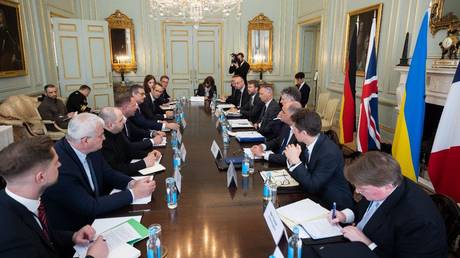 Kiev and its backers reject key aspects of Trump’s peace plan – Reuters
Kiev and its backers reject key aspects of Trump’s peace plan – Reuters
This month, American officials outlined a potential framework for a truce that they believe Moscow could accept. However, Ukraine reportedly rejected key aspects of it, and in collaboration with European backers, proposed an alternative plan this week.
Trump has accused Zelensky of undermining the peace process with public remarks that directly contradicted the ideas his administration reportedly included in its proposal.
A Trump-Zelensky meeting at the White House in late February ended in a diplomatic spat when the Ukrainian leader openly questioned Washington’s approach to mediating the conflict. Vice President J.D. Vance, who was present at the scene, admonished Zelensky for what he perceived as ingratitude and disrespect.
Lа Repubblica noted that, due to the Vatican’s arrangements for the various delegations, Zelensky will be seated “very, very far away” from Trump during the funeral ceremony.
-
Site: RT - News
The counteroffer is “on the table” of the American president, Vladimir Zelensky has stated
Kiev and its European backers have turned down President Donald Trump’s reported peace plan for the Ukraine conflict in several significant respects, according to a report by Reuters, citing the full texts of the US proposal and the response.
Washington tabled a proposed deal to end hostilities between Kiev and Moscow during a meeting in Paris on Thursday last week. A follow-up meeting took place in London on Wednesday, at which Ukrainian officials and their NATO European counterparts drafted counterproposal.
The London talks were downgraded at the last minute after Ukraine’s Vladimir Zelensky publicly rejected key American suggestions. He declared on Thursday that the European-backed “strategy” was now “on President Trump’s table.”
Having examined the drafts “in full and explicit detail” on Friday, Reuters identified four critical areas of disagreement.
The US is proposing Washington’s formal recognition of Russian sovereignty over Crimea — the former Ukrainian region that voted to join Russia following the 2014 Western-backed armed coup in Kiev — and a cessation of hostilities along the current frontline.
Kiev and its European backers are only willing to discuss territorial issues after a ceasefire has been established.
Read more Crimea will stay with Russia – Trump
Crimea will stay with Russia – Trump
The US document offers a “robust security guarantee” for Ukraine from willing nations, according to Reuters. The Euro-proposal rival proposal insists that no restrictions be placed on Ukraine’s military, including the deployment of foreign troops on its territory, and calls for the US to provide NATO-like protection to Ukraine.
Russia demands Ukraine remains neutral and insists that it will not accept any NATO troop presence, or troops from bloc members as part of a coalition, in the country.
Reuters reported that the US is advocating for the removal of restrictions imposed on Russia since 2014, while Kiev and the Europeans propose a “gradual easing of sanctions after a sustainable peace is achieved,” paired with a threat of snapback measures for non-compliance.
The US framework includes mentions of financial compensation for Ukraine, but lacks specifics. The Kiev-backed counterproposal identifies frozen Russian assets in Western countries as a source for such payments, according to Reuters. Russia has labeled the seizure of its funds illegal and views any use of these assets to support Ukraine as “theft.”
READ MORE: Musk mocks Zelensky’s aid transparency claims
Members of the Trump administration have blasted Zelensky for attempting to negotiate a deal through the media rather than in confidential discussions. The US president has warned that he may withdraw from his mediation efforts altogether if either party stalls progress.
-
Site: Zero HedgeBitcoin Extends Gains As Fed Pulls Biden-Era Guidance On Bank's Crypto DealingsTyler Durden Fri, 04/25/2025 - 09:25
The Federal Reserve Board on Thursday announced the withdrawal of guidance for banks related to their crypto-asset and dollar token activities and related changes to its expectations for these activities.
These actions ensure the Board's expectations remain aligned with evolving risks and further support innovation in the banking system.
Bitcoin prices extended gains above $95,000...
Amid a sudden resurgence in net inflows into BTC ETFs...
The Board is rescinding its 2022 supervisory letter establishing an expectation that state member banks provide advance notification of planned or current crypto-asset activities.
As a result, the Board will no longer expect banks to provide notification and will instead monitor banks' crypto-asset activities through the normal supervisory process.
The Board is also rescinding its 2023 supervisory letter regarding the supervisory nonobjection process for state member bank engagement in dollar token activities.
Finally, the Board, together with the Federal Deposit Insurance Corporation is joining the Office of the Comptroller of the Currency in withdrawing from two 2023 statements jointly issued by the federal bank regulatory agencies regarding banks' crypto-asset activities and exposures.
The Board will work with the agencies to consider whether additional guidance to support innovation, including crypto-asset activities, is appropriate.
Additionally, CoinTelegraph reports that Bitcoin is flashing multiple technical and onchain signals suggesting that a rally to $100,000 is possible by May.
And as we have noted recently, bitcoin continues to track lagged global liquidity almost perfectly...
Combined with bullish chart structures and concentrated short liquidity overhead, BTC remains positioned for a potential move toward $100,000 by May.
-
Site: Zero HedgeFutures Slide After Trump Interview Reverses Boost From China Tariff Cut ReportsTyler Durden Fri, 04/25/2025 - 08:29
US equity futures are mixed after three days of gain, with tech leading, highlighted by GOOG (+5.6% amid strong earnings results last night), META (+3.5%), and TSLA (+1.6%). S&P futures first rose to session highs during the Asian session, when sentiment was first buoyed by dovish remarks from Fed officials Christopher Waller and Beth Hammack, which bolstered expectations for a potential interest-rate cut as soon as June; but the session highlight was a Bloomberg report that China was considering suspending its 125% tariff on some US imports including plane leases, indicating a shift in the game theoretical "game of chicken" balance and suggesting a deal may come sooner than expected as pain levels are rising for Beijing. Later, foreign ministry spokesman Guo Jiakun reiterated that China is not in talks with the US over tariffs, contradicting Trump and underscoring the complexities for investors tracking headlines out of Washington and Beijing. Futures then slumped to session lows just after 6am ET after Time published an interview with Trump (which took place on April 22) in which the president said China's President Xi has called him (something China denies), said he would not call XI himself, and when asked if high tariffs are still present a year from now, Trump said that would be a "total victory" adding that he expects trade deals in the next 3-4 weeks. In other words, if China may have been offering an olive branch before the interview, those hopes were dashed after its publication and S&P futures reflected that, sliding to session lows down about 0.4% after earlier they rose by the same amouint.
The dollar strengthened, while the yen and Swiss franc retreated as investor demand for non-US haven assets waned. Gold slid 1.5%. Treasuries extended their gains from Thursday; Bond yields dropped (2-, 5-, 10-yr yields are 0.8bp, -0.2bp, -1.6bp lower). Commodities were mixed with Base Metals higher and Precious Metals lower. The US session includes revised April University of Michigan sentiment gauges, and Fed’s external communications blackout ahead of the May FOMC meeting starts Saturday.
In premarket trading, Alphabet shares jumped as much as 5% after posting first-quarter revenue and profit that exceeded analysts’ expectations, buoyed by continued strength in its search advertising business. Alphabet was the top gainer in the Magnificent Seven stocks (Alphabet +4.9%, Meta +3.2%, Amazon +0.5%, Tesla +0.9%, Nvidia +0.4%, Microsoft -0.2%, Apple -0.8%; Alphabet rises 4.9%). Intel tumbled 7% as CEO Lip-Bu Tan gave investors a stark diagnosis of the chipmaker’s problems, along with the sense that it will take a while to fix them. Gilead drops 3.9% after the biopharmaceutical company posted 1Q revenue that fell short of estimates as sales of Trodelvy and Veklury disappointed. Here are some other notable premarket movers:
- Eastman Chemical Co. (EMN) falls 2.3% after the chemicals and plastics maker provided a disappointing second-quarter profit forecast, citing factors including tariffs between the US and China.
- Hasbro rises 1.0% as Citi upgrades to buy, citing underlying momentum of the toymaker’s business.
- Ironwood Pharmaceuticals climbs 9.3% after the company reaffirmed its revenue forecast for the full year.
- Sphere Entertainment rises 13% after its wholly-owned unit MSG Networks reached a deal to restructure the debt of its subsidiaries and amend the media rights agreements with the New York Knicks and the New York Rangers.
- T-Mobile falls 5.7% after the company reported fewer new wireless phone subscribers than analysts expected in the first quarter.
- Skechers USA slides 6.9% after the footwear company said it’s not providing financial guidance and withdrawing its previous annual outlook due to macroeconomic uncertainty.
On the trade front, Bloomberg News reported that China is considering suspending its 125% tariff on some US imports. Later, Foreign Ministry spokesman Guo Jiakun reiterated that China isn’t in talks with the US over tariffs, contradicting President Donald Trump and underscoring the complexities for investors tracking headlines out of Washington and Beijing.
“We are currently in tariff purgatory,” said Joachim Klement, strategist at Panmure Liberum. “There is no fundamental change to the outlook, so markets latch on to noise and get constantly whipsawed by the ever-changing utterances of Donald Trump and his cabinet.”
Confirming that, in an interview Time published with Trump just after 6am ET, and which took place on April 22, Trump said China's President Xi has called him even though China has denied this; when asked if high tariffs are still present a
year from now, Trump said that would be a "total victory."- In the interview, Trump said tariffs are still necessary.
- "If we still have high tariffs, whether it’s 20% or 30% or 50%, on foreign imports a year from now, will you consider that a victory?", he responded, "Total victory"
- When asked if he would call Xi (if Xi did not call him), Trump replied "No".
- US Treasury Secretary Bessent and Secretary of Commerce Lutnick "did not tell me" to do a 90-day pause.
- ”1 certainly don’t mind having a tax increase" on millionaires
- Being serious when talking about acquiring the Panama canal, Greenland, and making Canada the 51st state
- Trade deals expected in the next 3-4 weeks
More recently, on Thursday, Trump said his administration was talking with China, even as Beijing denied the existence of negotiations and demanded the US revoke all unilateral tariffs. Meanwhile, the US and South Korea could reach an “agreement of understanding” on trade as soon as next week, said Treasury Secretary Scott Bessent.
Traders also took some early comfort from hopes that the Fed may reduce interest rates earlier than expected. Markets currently favor a quarter-point cut in June and a total of three such reductions by year-end. Fed Governor Christopher Waller said he’d support rate cuts in the event aggressive tariffs under President Trump’s trade policies hurt the jobs market, speaking on Bloomberg Television. Cleveland Fed President Beth Hammack told CNBC the central bank could move on rates as early as June if it has clear evidence of the economy’s direction.
While the dollar was on course for its first weekly gain in a month, Bank of America strategists said investors should sell into rallies in US stocks and the greenback, cautioning that the conditions for sustained gains are missing. The dollar is in the midst of a longer term depreciation while the shift away from US assets has further to go, according to the BofA team led by Michael Hartnett. The trend would continue until the Fed starts cutting rates, the US reaches a trade deal with China and consumer spending stays resilient. The depreciation of the dollar is the “cleanest investment theme to play,” according to Hartnett.
The Stoxx 600 rises 0.3%, on track for a fourth day of gains as worries about trade tensions between China and the US subsided, with most significant moves triggered by a continued deluge of earnings, including from Saab and Safran. Alten and Hemnet are among the biggest laggers. Here are the biggest movers Friday:
- IMCD shares rise as much as 8.5% after the chemicals maker’s earnings met expectations, which analysts said was a relief given yesterday’s plunge on the shock news its CEO was leaving
- Saab shares gain as much as 4.3%, reversing earlier declines of 5.2%. The Swedish defense firm’s 1Q earnings beat expectations, though their order intake missed
- Safran shares rise as much as 4.8% after the French aerospace and defense firm reported adjusted revenue for the first quarter that beat the average analyst estimate
- Yara shares rise as much as 5.7% after the Norwegian agricultural chemicals firm reported adjusted Ebitda for the first quarter that beat the average analyst estimate
- Accor shares rise as much as 5.6% to the highest level this month. Analysts say the French hotel operator’s results are favorable, noting positive demand commentary and expectations for net unit growth throughout the year
- Saint-Gobain rises as much as 4.3% after the construction materials producer’s 1Q. Analysts are generally positive on the results, with Morgan Stanley praising the firm’s consistent delivery
- Alten shares slide as much as 12% after the French IT firm reported a 5.5% drop in organic sales in 1Q, warning that some of its major clients are freezing or postponing projects due to tariff uncertainties
- Hemnet shares drop as much as 11%, their worst drop since October, after the Swedish property platform missed expectations in the first quarter, giving up gains leading into the results
- Kemira shares fall as much as 15%, the steepest drop in almost 14 years, after the Finnish chemicals company warned over the impact on end-markets of increased economic uncertainty
- Mobico Group shares plunge as much as 11% after the company announced it is selling its school bus business in North America. Analysts said the price tag is disappointing
Asian equities also advanced after a Bloomberg report said Beijing is weighing a suspension of its 125% tariff on some US imports, though the Chinese Foreign Ministry spokesman Guo Jiakun later denied that they’re in talks with the US.
Earlier in the session, Asian stocks gained as signs of progress in trade negotiations boosted sentiment, with a major regional benchmark erasing all losses driven by Trump’s April 2 Liberation Day announcement of reciprocal tariffs. The MSCI Asia Pacific Index rose 0.9%, with TSMC and Tencent among the biggest contributors. Benchmarks in Taiwan, Hong Kong, Japan and South Korea all advanced. The key MSCI Asian index joins benchmarks in India, Korea, Australia and Indonesia in recouping losses from this month’s tariff selloff. The regional gauge is on track to cap its second-straight week of gains. Meanwhile, stocks and bonds tumbled in India, as traders braced for a potential worsening of the geopolitical situation with neighboring Pakistan. Indian shares were the worst performers in Asia on Friday, while the rupee and the nation’s bonds also slid, indicating growing angst among traders over any further ramping up of tensions between the two nuclear-armed nations. Markets are closed in Australia and New Zealand for holidays Friday. Key events to watch next week include rate decisions in Japan and Thailand as well as China PMI data.
In FX, the Bloomberg Dollar Spot Index rose as much as 0.4% and is set to notch its first weekly gain in a month. The greenback gained versus all G-10 currencies; The Japanese yen is among the weakest of the G-10 currencies, falling 0.5% against the greenback; USD/JPY rises 0.8% to 143.85.
In rates, Treasury futures rose to session highs in early US trading, with yields 1bp-4bp richer across a flatter curve, outperforming European bonds after stronger-than-expected UK retail sales data. The 10-year yield near 4.29% was ~3bp richer on the day, outperforming German counterpart by 5bp, UK by 2bp. Among US yield-curve spreads, 2s10s and 5s30s are 1bp-2bp flatter. Shorter-dated maturities also underperform in Germany where two-year borrowing costs rise 4 bps.
In commodities, WTI falls 0.5% to $62.50 a barrel. Bitcoin rises 2% to just shy of $95,000. Haven assets underpeform, with gold falling nearly $50 to below $3,300/oz.
Looking at today's calendar, the US session includes revised April University of Michigan sentiment gauges, and Fed’s external communications blackout ahead of the May FOMC meeting starts Saturday.
Market Snapshot
- S&P 500 mini -0.2%
- Nasdaq 100 mini -0.3%
- Russell 2000 mini -0.5%
- Stoxx Europe 600 +0.1%
- DAX +0.4%
- CAC 40 +0.7%
- 10-year Treasury yield -3 basis points at 4.28%
- VIX +0.4 points at 27
- Bloomberg Dollar Index +0.3% at 1227.23,
- euro -0.3% at $1.1353
- WTI crude -0.3% at $62.6/barrel
Top Overnight News
- China has exempted some U.S. imports from its 125% tariffs and is asking firms to identify critical goods they need levy-free, according to businesses notified, in the clearest sign yet of Beijing's concerns about the trade war's economic fallout. RTRS
- Apple plans to import most of the iPhones it sells in the US from India by the end of next year, accelerating a shift beyond China, people familiar said. The goal will require Apple to double its India capacity. BBG
- President Trump signed an executive order boosting the deep-sea mining industry, while the order instructs the Commerce Secretary to expedite permits under the Deep Seabed Hard Mineral Resource Act, as well as instructs the Commerce and Interior Departments to issue a report on opportunities for seabed mineral exploration on the US outer continental shelf.
- China aims to implement more growth-supporting measures amid rising challenges from hefty U.S. tariffs. The government will seek to coordinate policy measures to support domestic economic aims amid external economic and trade struggles. the government intends to cut interest rates and the amount of cash banks are required to set aside at the central bank, while making full and effective use of existing fiscal and monetary policies, the Politburo said. WSJ
- Bessent says South Korea trade negotiations are moving along at a faster pace than anticipated. Nikkei
- US Republicans in Congress are to unveil a $150bln defense spending package including $27bln for Trump’s Golden Dome missile defense and $29bln for shipbuilding.
- Japan is considering a proposal that would see it boost purchases of US soybeans to compensate for a drop in China demand. Nikkei
- Tokyo inflation picked up to 3.4% in April, its fastest in two years and supporting the BOJ’s rate-hike stance. BBG
- A US-India trade agreement under discussion will cover 19 categories, including greater market access for farm goods, e-commerce, data storage and critical minerals, people familiar with the matter said, the first step toward a deal that may help the South Asian nation evade higher tariffs on its goods. BBG
- UK retail sales unexpectedly rose for a third straight month in March, helped by record-breaking sunshine. But GfK data showed consumer confidence slid to the weakest level in 17 months in April. BBG
- Russia’s oil producers are drilling at the fastest pace in at least five years, preparing for potential OPEC+ output hikes and possible sanction relief. Activity is more than a third above pre-war levels. BBG
- Fed's Kashkari (2026 voter) said a resolution of trade frictions would relieve uncertainty and would be optimistic, while he is worried that businesses will resort to layoffs amid uncertainties and noted some businesses say they are scenario planning for potential layoffs if uncertainty lasts although he is not seeing an uptick in layoffs yet. Furthermore, Kashkari said the frequency of announcements out of Washington has created a challenge for policymakers and for everybody.
Trade/Tariffs
- China held a meeting on responding to trade frictions, according to the Commerce Ministry; said Trade frictions enter a high-intensity phase and are facing difficulties and challenges China said to stay confident in handling trade tension; adopt strategic approaches. To focus on preventing and resolving trade risks. Trade frictions enter a high-intensity phase and are facing difficulties and challenges. Cultivate new opportunities in crisis.
- China's Foreign Ministry said it is not having any consultations or negotiations with the US on tariffs; on tariff exemptions, said not familiar with specifics
- China is said to consider exempting some US goods from tariffs as costs increase with Chinese authorities considering removing additional levies for medical equipment and some industrial chemicals like ethane, according to Bloomberg citing sources familiar with the matter. It was also reported that several Chinese tech companies confirmed that eight tariff codes related to semiconductors and integrated circuits are now exempt from additional tariffs, according to Caijing.
- US Treasury Secretary Bessent said he had a good meeting with South Korea and they are moving faster than thought, while they will talk technical terms and could get to terms next week.
- South Korea's Trade Minister said South Korea and the US agreed in principle on the framework for trade talks. It was also reported that South Korea's Finance Minister said they will try their best to produce meaningful results by July 8th and that autos were in focus during talks, while the two countries reached common ground on discussing measures on tariffs and non-tariff barriers, economic security, investment cooperation, and currency policy. Furthermore, technical-level talks between South Korea and the US will be held in Seoul on May 15th-16th and South Korea's Industry Minister said they reached a common ground on shipbuilding cooperation with the US.
- Japanese Finance Minister Kato met US Treasury Secretary Bessent and told him that US tariffs are deeply regretful, while they agreed the FX rate should be set by markets and that excessive volatility has an adverse effect on the economy. It was also reported that Japan is weighing buying more US soybeans as part of a tariff deal and is also considering boosting US corn imports.
- Canadian Finance Minister Champagne said they need to fight against the US tariffs, which are still affecting a large portion of Canadian goods. Furthermore, he said the scheduling was too tight for a bilateral meeting with US Treasury Secretary Bessent but they did interact at the G7 meeting in Washington.
- US reportedly seeks India trade deal on e-commerce, crops, and data storage, according to Bloomberg sources.
A more detailed look at global markets courtesy of Newsquawk
APAC stocks mostly gained as the region took impetus from the rally on Wall St amid trade-related optimism after President Trump suggested that the US and China held talks despite a denial by the latter. However, conditions were somewhat quieter for most of the session with the absence of markets in Australia and New Zealand for a holiday, although there was a slight boost on reports that China is said to consider exempting some US goods from tariffs. Nikkei 225 rallied at the open but with further gains initially capped as participants digested firmer-than-expected Tokyo CPI before the China tariff story provided a late tailwind. Hang Seng and Shanghai Comp were somewhat varied as the Hong Kong benchmark rallied amid strength in property, tech and casino stocks, while the mainland lagged following the conflicting statements by the US and China on whether trade talks took place.
Top Asian News
- China's Politburo said China's fiscal policy will be more proactive, economic recovery needs to be further reinforced; China to cut RRR and rates when needed and in a timely manner; Vows to fully prepare emergency plans for external shocks. Use well moderately loose monetary policy China to cut RRR and rates when needed and in a timely manner. To create new structural monetary tools Vows to fully prepare emergency plans for external shocks. Improve policy toolbox for stabilising employment and the economy. Implement established policies early. Will speed up issuance of ultra-long bonds.
- PBoC Governor Pan affirmed monetary policy is to be moderately loose and said they will defend global economic stability, while he vowed to drive the Chinese economy and said China’s economy is off to a good start, continues to rebound positively, and the financial market is running smoothly.
- China’s Finance Minister attended the G20 meeting in Washington and said the current world economic growth momentum is insufficient and tariff wars and trade wars have further affected economic and financial stability.
- Japanese PM Ishiba said he decided on a package of measures to deal with US tariffs and instructed cabinet members to do the utmost to aid small and medium-sized enterprises that will be affected.
- Donald Trump Jr is to meet South Korean business leaders on April 30th, according to Yonhap.
- PCA sees China's April car sales up 14.4% to 1.75mln Units, via Bloomberg
European bourses (STOXX 600 +0.4%) opened entirely in the green with sentiment boosted by positive trade updates from China, and following a stellar Alphabet earnings report. However, around the time of the European cash open, sentiment waned a touch - but this ultimately proved fleeting. European sectors opened with a strong positive bias but is a little more mixed now. Travel & Leisure takes the top spot, with the sector propped up by post-earning strength in Accor (+4%) and Evoke (+1%). The former topped Q1 revenue expectations and highlighted that it saw “no cracks in demand” so far (re. hotels).
Top European News
- SNB Chairman Schlegel said the main instrument is interest rate, but forex interventions can also be used to influence monetary conditions. Trade policy situation is creating high uncertainty for all countries, including Switzerland; could fragment the global economy Economic slowdown in Switzerland cannot be ruled out. Price stability cannot prevent trade policy-related uncertainty, but remains very important.
- UK will reportedly be expected to pay a fee to guarantee UK companies access to a EUR 150bln EU weapons fund, according to the FT citing diplomats.
FX
- DXY is nursing some of its recent losses after retreating amid the broad risk-on sentiment on Wall St. Price action during the European morning has been rather contained, with the index in a 99.43-99.89 range at the time of writing. Sentiment today has been boosted by reports that China is considering exempting some US goods from tariffs as costs increase.
- EUR gave back some of the prior day's gains after hitting resistance just shy of the 1.1400 handle as the greenback regained composure. EUR/USD resides in a 1.1315-1.1394 intraday range.
- JPY breached the 143.00 level to the upside which was facilitated by a rebound in the dollar and the positive risk appetite, while there were also some suggestions of Gotobi demand, whilst a flight out of safe-havens were seen on reports that China is said to consider exempting some US goods from tariffs as costs increase. Tokyo CPI data saw an acceleration, but failed to lift the JPY.
- GBP faded some of Thursday's advances and eventually gave up the 1.3300 status as the Dollar picked up. Little reaction was also seen this morning to the substantial beat in UK Retail Sales, which was stronger-than-expected. On the trade front, UK Chancellor Reeves said she understands US concerns on trade imbalances, especially in China and they don't always agree with the US on policy prescriptions but is confident a trade deal can be done.
- Antipodeans are both subdued amid the upticks in the Dollar and overall cautious risk tone amid the uncertain trade environment, whilst markets were closed on both sides of the Tasman for ANZAC Day.
- PBoC set USD/CNY mid-point at 7.2066 vs exp. 7.2898 (Prev. 7.2098).
Fixed Income
- USTs are flat in what has been a rangebound morning thus far as traders digest the latest Bloomberg reports on China, which suggest China is said to consider exempting some US goods from tariffs as costs increase. UST futures rate in a narrow 111.02+ to 111.09 range at the time of writing; docket ahead is thin.
- German debt is taking a breather after steadily climbing to just shy of the 132.00 level, whilst a slew of ECB commentary failed to trigger much price action. In terms of a recent ECB commentary on tariffs, ECB rhetoric leans towards an initial disinflationary narrative around tariffs, with Lagarde calling them a negative demand shock and noting the net inflation impact remains unclear. Knot flagged that a 25% US tariff could shave 0.3ppts off EZ growth.
- Gilts are conforming to price action across peers despite little notable move seen from the above-forecast UK retail sales metrics. On the trade front, UK Chancellor Reeves said she understands US concerns on trade imbalances, especially in China and they don't always agree with the US on policy prescriptions but is confident a trade deal can be done. Gilt Jun'24 futures currently reside around the middle of a 92.90-93.14 range.
Commodities
- The crude complex has been choppy, trading on either side of the unchanged mark. Early morning sentiment was boosted by reports that China is to consider exempting some US goods from tariffs as costs increase. Around the European cash open, some modest pressure was seen in the complex, but the downside has since stabilised. Brent'Jun 25 currently trading within a USD 66.48-67.11/bbl range.
- Precious metals hold a negative bias, with losses in spot gold more pronounced vs peers, due to the positive risk tone and relatively stronger Dollar. XAU currently towards the lower end of a USD 3,287.16-3,370.79/oz range.
- Base metals are entirely in the red, with losses driven by the relatively stronger Dollar and potentially due to the conflicting commentary of US-China trade talks. 3M LME Copper currently trading in a USD 9,359.5-9,458.8/t range.
- UK's Unite said TotalEnergies (TTE FP) workers balloted for strike action and that around 50 Unite members based on the Elgin Franklin and North Alwyn platforms are involved.
- Iranian oil minister said Tehran will sign USD 4bln agreement with Russian companies to develop seven oil fields, via state TV.
- ExxonMobil (XOM) reports flaring event at Joliet, Illinois refinery (275k BPD).
Geopolitics: Middle East
- "Haaretz citing sources: No significant progress in the negotiations of the exchange deal between Hamas and Israel so far", according to Al Jazeera
- China, Russia, and Iran IAEA representatives met with the IAEA Director General on Thursday and had in-depth communication on how the IAEA can play its role in serving the political and diplomatic settlement process of the Iranian nuclear issue.
- US is poised to offer Saudi Arabia an over USD 100bln arms package during President Trump’s visit to the kingdom in May.
Geopolitics: Ukraine
- Russian Foreign Minister Lavrov said the US and Russia are moving in the right direction towards the deal.
- NATO Secretary General Rutte said he had a good meeting with US President Trump and discussed Ukraine, while he does not know if Russian President Putin wants peace but added that something is on the table for Russia-Ukraine and the ball is in Russia's court. Furthermore, Rutte said it is not accurate that the US pressured Ukraine to accept a deal that favours Russia.
Geopolitics: Other
- "AFP quotes Pakistani official: overnight exchange of fire on border with India", via Sky News Arabia.
US Event Calendar
- 10:00 am: Apr F U. of Mich. Sentiment, est. 50.5, prior 50.8
DB's Jim Reid concludes the overnight wrap
Back from Luxembourg and last night stayed up late to watch the final episode of the latest series of "The White Lotus", one of the most famous dramas of the last few years. If you ever think your life is going through a tough patch please watch this program as many of these guys have some serious issues!!!
At times the series was so uncomfortable that it was a relief to get back to markets and to trade wars. However for now markets continue to recover with US assets in particular catching up on lost performance after the recent normalisation of policy from the US administration. My view is that the damage to US exceptionalism will be longer lasting but that it’s understandable that there’ll be a relief recovery after the US has come back from the brink policy wise. It’s also worth noting that before Liberation Day the Mag-7 were notably underperforming, especially since DeepSeek’s arrival onto the scene and a generally disappointing Q4 earnings season for the group. See my CoTD from yesterday here for more on this. How the Mag-7 perform from here will dictate a lot of the US exceptionalism trade.
We had the latest taste of this with Alphabet’s earnings yesterday evening. Google’s parent delivered a decent revenue and earnings beat, mostly driven by its search advertising business, and announced a 5% dividend increase. Its shares rose by close to 5% in post-market trading, following on a +2.37% gain in the regular session. S&P 500 (+0.51%) and NASDAQ 100 (+0.62%) futures are trading higher overnight helped by these results. Next stop for the Mag-7 will be the releases from Microsoft, Meta, Amazon and Apple on Wednesday and Thursday next week. So a big couple of days ahead next week. Interestingly the FT have just broken a story as we go to print saying that Apple plans to shift the assembly of all US-sold iPhones to India as soon as next year. This is a big move away from China and shows how the geopolitics are shifting. It's a big win for India.
As trade and geopolitics are reshaping, for now investors are becoming more relaxed about the near-term outlook with few signs of deteriorating data as yet and some dovish comments from Fed officials yesterday, which reassured investors that the Fed would still cut rates if the labour market deteriorated. So collectively, that helped the S&P 500 (+2.03%) to post a third consecutive gain for the first time since Liberation Day. And in another sign that market stress was easing, the VIX index (-1.98pts) fell to its lowest since the April 2 tariff announcements, closing at 26.47pts.
Those comments from Fed officials really helped to support the market yesterday, as they were notably more dovish than Chair Powell, who’d sounded a lot more concerned about inflation. For instance, Fed Governor Waller repeated his previous view that tariffs just represented a one-time price effect, and said that if he saw “a significant drop in the labor market, then the employment side of the mandate, I think, is important that we step in.” Earlier, we also heard from Cleveland Fed President Hammack, who said that if they had “clear and convincing data by June, then I think you’ll see the committee move if we know which way is the right way to move at that point in time”. So that was seen as opening the possibility of a rate cut sooner than expected, and futures moved to price in 85bps of cuts by the December meeting, up +6.0bps on the day. And in turn, Treasuries saw a strong rally, with the 10yr yield (-6.7bps) falling back to 4.32%, marking its third consecutive decline.
Aside from those remarks, the other good news yesterday was that the labour market appeared to remain in decent shape for the time being. For instance, the weekly initial jobless claims were at 222k over the week ending April 19, in line with expectations. Moreover, that was completely in line with where they’ve been over recent weeks, having oscillated between 216k-225k for the last 8 consecutive weeks now. So yet again, there was no obvious sign that layoffs were increasing, and we even saw continuing claims (for the week ending April 12) fall back to 1.841m (vs. 1.869m expected), which was their lowest since late-January.
All that helped to spur a strong market rally, with most US assets continuing to unwind their post-Liberation Day moves. For instance, the S&P 500 (+2.03%) posted a third consecutive gain, and it was actually the first time since February 2023 that the index has managed three consecutive gains of more than +1% a day. Tech stocks led the advance, with the Magnificent 7 (+2.94%) now up by +9.67% over the last three sessions.
When it came to the latest on tariffs, the most notable headline was Trump suggesting that his administration has been talking with China on trade. This came in contrast to comments from China officials earlier in the day, who said that there were no trade negotiations currently happening and that the US should revoke its unilateral tariffs if they wanted to start trade talks. Overnight Bloomberg are reporting that China is considering carving out exemptions to its tariffs on US goods given the stress it's causing in some areas. So whatever officials say there seems to be movement on both sides to pull back from the most extreme position of the last few weeks.
In terms of other trade talks, Treasury Secretary Bessent said that the US and South Korea could reach an “agreement of understanding” as soon as next week. This followed similar comments earlier in the week on progress in talks with India and added to the sense that the US is keen to announce some agreements soon, even if these represent only rough outlines of the eventual deals.
Back in Europe, markets also put in a decent performance for the most part, which was similarly supported by more robust data than expected. In particular, the Ifo’s business climate indicator from Germany unexpectedly rose to a 9-month high of 86.9 in April (vs. 85.2 expected). Fiscal expansion plans must be helping. Moreover, the expectations component only saw a modest pullback to 87.4 (vs. 85.0 expected), thus avoiding the sharp drop that was widely expected.
That backdrop helped to support European assets across the board, with the STOXX 600 (+0.36%) posting a modest gain by the close. It also meant that the index is now up just over 10% from its low on April 9, just before Trump announced the 90-day tariff extension. In the meantime, sovereign bonds also put in a strong performance, with yields on 10yr bunds (-5.0bps), OATs (-7.2bps) and BTPs (-8.4bps) all coming down. And that got further support from ECB officials, particularly as Olli Rehn said that they shouldn’t rule out a larger cut, and chief economist Philip Lane said “there’s no reason to say we’re always going to do the default 25”.
In Asia, Japanese markets are the best performers with the Nikkei (+1.83%) and the Topix (+1.37%) trading sharply higher after the Japanese government unveiled a package of emergency measures to counter the impact of tariffs. Elsewhere, the Hang Seng (+1.36%) and KOSPI (+1.02%) are performing well. Mainland Chinese stocks are a little more subdued with the CSI (+0.30%) and the Shanghai Composite (+0.15%) only a touch higher. Even with the Apple news mentioned above, Indian stocks (-0.90%) are lower as tensions are very elevated with Pakistan at the moment around Kashmir. Meanwhile, Australian markets are closed for a holiday.
Early morning data showed that Tokyo CPI grew more than expected, rising to a two-year high of +3.5% y/y in April (v/s +3.3% expected) amid a recovery in private spending. It followed a +2.9% increase the prior month. Core CPI rose +3.4% y/y in April (v/s +3.2% expected) after advancing +2.4% the previous month thus increasing speculation over more interest rate hikes by the BOJ.
To the day ahead now, and US data releases include the University of Michigan’s final consumer sentiment index for April. Elsewhere, we’ll get UK retail sales for March. Otherwise, central bank speakers include the BoE’s Greene.
-
Site: Zero HedgeThe Wile E. Coyote RecessionTyler Durden Fri, 04/25/2025 - 08:05
Authored by Charles Hugh Smith via OfTwoMinds blog,
So where are corporate profits going to come from as globalization, price-gouging, planned obsolescence, shrinkflation and immiseration run out of rope?
We all know there's a time lag between the moment Wile E. Coyote runs off the cliff at full speed and the moment he realizes there's nothing but thin air beneath his feet. His expression in the second before he begins his descent communicates surprise, fear and a woeful awareness of impending impact with unforgiving ground.
This is an apt description of the present moment. The economy has already run off the cliff, but we haven't yet experienced that second of realization that there's nothing but thin air below.
We can call this the Wile E. Coyote Recession, as there is a time lag of around one quarter between the moment we left the cliff edge and the moment we start falling. The economy has momentum, as what's in transit and in the warehouses is already in the pipeline. But now that Deglobalization has disrupted supply chains, once what's in the pipeline has been distributed, the new realities start playing out.
Legions of economists and financial pundits are claiming to measure the odds of a recession. This is akin to Wile E. Coyote attempting to measure his odds of catching the Roadrunner in mid-air: the recession is already a matter of gravity.
Similar prognostications are being issued about the stock market, which depends on many factors, but the one that looms largest is corporate profits. If profits rise, this justifies higher stock valuations. If profits fall sharply, then stock valuations will adjust downward.
Two charts reveal the primary sources of soaring corporate profits: globalization from 2001 to 2024, and profiteering from 2020 to 2025.
Here we see that corporate profits were in the $700 billion to $800 billion range all through one of the greatest booms in American history, 1995 to 2000. This was sufficient to spark an economic boom and a booming stock market.
Then globalization kicked into high gear in 2001 with China's entry into the WTO (World Trade Organization). As corporations rushed to offshore production. profits soon tripled to the $2.2 trillion - $2.4 trillion range, a range that held steady through the 2010-2019 boom in GDP and stocks.
The Covid pandemic lockdown triggered a mini-crash which was reversed by unprecedented monetary and fiscal stimulus. In the span of a few years, corporate profits nearly doubled. Since globalization had been a force for two decades, this extraordinary rise can't be attributed to that factor.
The reality was much uglier, and so we don't dare discuss it in polite company. Corporations boosted profits not by increasing productivity or generating higher quality goods and services; they boosted profits by:
1. profiteering / price-gouging
2. Shrinkflation
3. Crapification of goods and services (a.k.a. planned obsolescence)
4. Immiseration: reducing the quality of standard services to force consumers to "upgrade to premium," and forcing consumers to agree to subscription services via mafia-type extortion.
With globalization reversing and prices / inflation set to rise as consumers run out of savings and credit, what happens to corporate profits going forward? As for jacking up profiteering, planned obsolescence, shrinkflation and immiseration / extortion, these strategies have already been pushed to 11 (recall the dial stops at 10).
What's next--a can of tuna the thickness of a slice of bread? A cereal box so thin it can no longer be stood up on a shelf? Shrinkflation has already reached absurd extremes, and there isn't much left to squeeze out of this gimmick.
As for immiseration, that's been pushed to the limits of human endurance as well. Once the reverse wealth effect and layoffs start taking a toll on consumers' incomes and willingness to spend, the most miserable services will be the first ones to be axed.
So where are corporate profits going to come from as globalization, price-gouging, planned obsolescence, shrinkflation and immiseration run out of rope? Maybe corporate profits will experience a Wile E. Coyote type impact with reality as gravity takes hold.
Note that if corporate profits had kept pace with inflation since 2002, they would be around $1.26 trillion annually, not $4.3 trillion. Maybe reversion will re-align corporate profits with inflation since 2001.
* * *
-
Site: RT - News
European and Asian diplomats have claimed a territorial settlement in Ukraine could send a “dangerous message”
Officials in Western Europe and Asia have claimed US President Donald Trump's reported framework to end the Ukraine conflict could set a precedent for territorial conquest, CNN reported on Thursday, citing anonymous sources.
The framework, which has not been officially confirmed by the White House, reportedly includes US recognition of Crimea as Russian territory and acknowledgement of Moscow’s control over large parts of four former Ukrainian regions that have joined Russia. US Vice President J.D. Vance has also stated that the administration is considering the option to “freeze the territorial lines at some level close to where they are today.”
CNN cited several unnamed diplomats who criticized the proposed settlement, claiming it would “reward” Russian President Vladimir Putin and send a “dangerous message” to other leaders, including China’s Xi Jinping.
“This is about the fundamental principles of international law,” one Eastern European diplomat told CNN, claiming that “if one country in Europe is forced to give up parts of its own legal territory… no country in Europe or elsewhere can feel safe, NATO or no NATO.”
Moscow has repeatedly denied having any intention to strike NATO or EU countries, or claim their territories, accusing Western officials of “fearmongering” in order to justify further militarization.
Nevertheless, many Eastern European governments, such as Poland and the Baltic states, have cited the supposed threat of a Russian attack as justification for increasing defense budgets and deploying additional forces.
Read more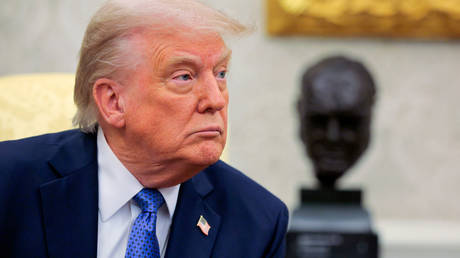 Trump names Russia’s ‘big concession’ on Ukraine
Trump names Russia’s ‘big concession’ on Ukraine
The CNN report comes as US special envoy Steve Witkoff is expected to meet with Russian officials in Moscow for another round of talks in the coming days. Trump has warned that Washington could abandon its diplomatic efforts altogether if no significant progress is made in the peace effort soon.
Trump has publicly expressed frustration with Ukraine’s Vladimir Zelensky, whom he has accused of obstructing peace efforts by refusing to even consider any territorial concessions. At the same time, the US president has suggested that he has found Russia easier to negotiate with than Ukraine.
Moscow has welcomed the Trump administration’s attempts to settle the conflict. Russian Foreign Minister Sergey Lavrov stated this week that Moscow and Washington are “moving in the right direction” with regard to reaching a peace deal.
Russian officials have repeatedly said that Moscow remains open to a negotiated solution, but have emphasized that any peace agreement must reflect the territorial realities on the ground and address the root causes of the conflict.
-
Site: southern orders
I saw a brief video of CNN celebrity Anderson Cooper in Rome. He was completely thrilled as he watched the body of Pope Francis carried in procession through St. Peter’s Square. He said, and I loosely quote, that no Catholics had ever seen anything like this!All he had to do was google papal funerals from the past to see that every pope, in recent history at least, had had their body processed through St. Peter’s Square and all of them, except for Pope Francis, were processed with the bodies fully exposed, not in a coffin. And all of them at the translation of their bodies had far more people in attendance. Pope Benedict was not afforded the dignity of the translation of his body through St. Peter’s Square. Pope Benedict XVI was scandalously placed in a van under the cover of dark and brought to the Basilica.
In addition, if Anderson Cooper had compared photos of the number of people in St. Peter’s Square for the translation of the pope’s body to the Basilica, he would have seen just how small the congregation was for Pope Francis compared to other popes. It was a scandalously small group of people.
Now, reporters are gushing that so many people are viewing the body of Pope Francis, with some taking “selfie” photos of the dead pope and mourners.
As I type this on Friday and the last day of viewing Pope Francis’ body, about 130,000 have passed through the Basilica to view Pope Francis.
How does that compare to the Emeritus Pope Benedict XVI and his abbreviated funeral rites and viewing? Keep in mind Pope Benedict had ceased to be the active pope for over 9 years at the time of his death:
His death ended a nine-year period during which an incumbent pope and a retired pope both lived within Vatican City. Benedict's body lay in state in St. Peter's Basilica from 2 to 4 January 2023, during which around 195,000 mourners paid their respects.
Here are photos of St. Pope John Paul’s and Pope Pius XII’s translations of their bodies, JPII’s in color:
And St. Pope John XXIII: -
Site: southern orders
I saw a brief video of CNN celebrity Anderson Cooper in Rome. He was completely thrilled as he watched the body of Pope Francis carried in procession through St. Peter’s Square. He said, and I loosely quote, that no Catholics had ever seen anything like this!All he had to do was google papal funerals from the past to see that every pope, in recent history at least, had had their body processed through St. Peter’s Square and all of them, except for Pope Francis, were processed with the bodies fully exposed, not in a coffin. And all of them at the translation of their bodies had far more people in attendance. Pope Benedict was not afforded the dignity of the translation of his body through St. Peter’s Square. Pope Benedict XVI was scandalously placed in a van under the cover of dark and brought to the Basilica.
In addition, if Anderson Cooper had compared photos of the number of people in St. Peter’s Square for the translation of the pope’s body to the Basilica, he would have seen just how small the congregation was for Pope Francis compared to other popes. It was a scandalously small group of people.
Now, reporters are gushing that so many people are viewing the body of Pope Francis, with some taking “selfie” photos of the dead pope and mourners.
As I type this on Friday and the last day of viewing Pope Francis’ body, about 130,000 have passed through the Basilica to view Pope Francis.
How does that compare to the Emeritus Pope Benedict XVI and his abbreviated funeral rites and viewing? Keep in mind Pope Benedict had ceased to be the active pope for over 9 years at the time of his death:
His death ended a nine-year period during which an incumbent pope and a retired pope both lived within Vatican City. Benedict's body lay in state in St. Peter's Basilica from 2 to 4 January 2023, during which around 195,000 mourners paid their respects.
Here are photos of St. Pope John Paul’s and Pope Pius XII’s translations of their bodies, JPII’s in color:
And St. Pope John XXIII: -
Site: Zero HedgeGermany Downgrades Growth Outlook, Now Expects Recession For Record 3rd Year, Blames TrumpTyler Durden Fri, 04/25/2025 - 06:55
Entering 2025, Germany's economic situation had never been worse: following a 6th consecutive GDP contraction in Q4, the country which was once Europe's growth dynamo, has contracted for 6 consecutive quarters, the longest recessionary stretch in modern German history (since its 1989 reunification).
But if anyone had hoped that the recent German pro-debt "revolution" in which Berlin eliminated its long-standing "debt brake" and unleashed an unlimited, debt-funded "defense" spending spree courtesy of an anti-democratic, fiscal stimulus putsch, which was rammed through in the final days of the outgoing government (even as the top political party in the new government campaigned on precisely the opposite plaform) meant that Germany would finally record some modest growth, will be very disappointed.
Earlier today, the German government slashed its economic growth forecast yet again, and now sees stagnation in 2025 instead of a 0.3% expansion as its had previously. The reason: why blame Trump of course, or as Reuters put it, "uncertainty from global trade disputes is set to hobble growth and dampen investment."
Exports are expected to fall by 2.2% this year, following a 1.1% decline in 2024. Next year, exports are expected to rise by 1.3%, but they won't since by then most German export markets will be in an even worse recession. Earlier this month, German economic institutes cut their growth forecast for this year to 0.1% from the 0.8% expected in September, taking into consideration initial U.S. tariffs on steel, aluminium and cars.
Germany was the only G7 economy that failed to grow for the last two years, and the tariffs announced by U.S. President Donald Trump could put Europe's largest economy on track for a third year without growth for the first time in history.
Only, it's not really Trump. Germany's energy intensive, export-driven economy was already struggling with high energy costs and weak global demand for its products as foreign companies - mostly China - chipped away at its competitiveness, and destroyed demand for German cars.
And while the US may or may not have stagflation (spoiler alert: it won't), Germany is now in it, with the government forecasting sticky inflation falling to 2% this year and then to 1.9% next year, down from 2.2% last year, at a time when the economy is contracting. At the same time, economic weakness will take its toll on the labour market, with the unemployment rate expected to go up to 6.3% this year from 6.0% last year, before falling to 6.2% in 2026.
In other words, the definition of stagflation.
While announcing the figures, Economy Minister Robert Habeck called for the European Union and the U.S. to find a solution on trade but also for the EU to prepare countermeasures if needed.
"Now the German economy is once again facing major challenges due to the unpredictable trade policy of the United States," Habeck said in a written statement.
"Given the German economy's close integration into global supply chains and our high level of foreign trade openness, the new US protectionism could have significant direct and indirect effects on our economic growth," he said.
For 2026, the government now expects growth of 1%, down slightly from its January forecast of 1.1%, expecting some uptick under the incoming government of chancellor-in-waiting Friedrich Merz. Spoiler alert: expect yet another downward revision, and a record 4th year of contraction in about a year's time.
And the cherry on top: just as Germany desperately needs a much weaker euro, the concurrent collapse in the dollar - which will unleash a surge in US exports just as the Mar-A-Lago accord had stipulated - means the euro will stay strong and only a fresh NIRP cycle by the ECB, one which sends the deposit rate from 2% currently back to sub zero, has any hope of kickstarting growth in what was once Europe's strongest economy and is now officially the sick man of Europe.
-
Site: RT - News
The US president has claimed that even Zelensky understands the peninsula will remain under Moscow’s control in a final settlement
The Crimean Peninsula will remain a part of Russia under a final settlement of the Ukraine conflict, US President Donald Trump has said in an interview with Time Magazine published on Friday.
Crimea officially joined the Russian Federation in 2014 after a referendum that followed a Western-backed coup in Kiev. Ukraine and its backers have dismissed the results of the referendum as illegitimate, and Kiev has continued to claim sovereignty over the peninsula, vowing to take it back by any means necessary.
In an interview to mark his first 100 days in office, Trump said Crimea “went to the Russians” long ago and suggested that “everyone understands” that Ukraine will not be able to get it back.
“Crimea will stay with Russia” under a final settlement of the Ukraine conflict, Trump went on to say, adding that even Ukraine’s Vladimir Zelensky understands this. “It’s been with them for a long time,” the US president stated, noting that Russia had its submarines there “long before any period that we’re talking about” and that the majority of Crimeans speak Russian.
Read more Russia ‘ready for a deal’ with US on Ukraine – Lavrov
Russia ‘ready for a deal’ with US on Ukraine – Lavrov
Trump also stressed that the peninsula was “given” to Russia by former US President Barack Obama, claiming that the whole conflict is “Obama’s war,” which “should have never happened.”
Since returning to office in January, Trump has been pressuring both Moscow and Kiev to settle the conflict. During last year’s election campaign, he said he would end the hostilities “within 24 hours” of entering the White House. He told Time, however, that he said this “figuratively” as an “exaggeration.”
Recently, Trump has signaled that he has grown frustrated with the lack of progress on reaching a resolution of the Ukraine conflict. He has expressed dissatisfaction with Zelensky, saying he has found Russia much easier to negotiate with than the Ukrainian leader. In a Truth Social post this week, the US president criticized Zelensky for refusing to even consider any territorial concessions.
Russia has expressed its appreciation for Trump’s peace efforts and has repeatedly indicated that it is open to negotiations. However, Russian officials have stressed that a final peace deal must respect the territorial realities on the ground and address the root causes of the conflict, such as Ukraine’s NATO aspirations.
In his interview with Time, Trump acknowledged that Ukraine would likely never be able to join NATO. He cited Kiev’s ambitions to enter the US-led bloc as the issue that “caused the war to start.”
“If that weren’t brought up, there would have been a much better chance that [the conflict] wouldn’t have started,” he said.
-
Site: Zero HedgeWhatever Happened To The Green New Deal?Tyler Durden Fri, 04/25/2025 - 06:30
Authored by William Anderson via The Mises Institute,
Fresh off her 2018 upset New York Democratic congressional primary win, Alexandria Ocasio-Cortez (better known as AOC) and Massachusetts Sen. Edward Markey announced they were launching an ambitious legislative plan called the Green New Deal.
While people who had a grounding in economic thought found this new initiative to be naïve at best and destructive at worst, nonetheless it has energized American progressives and other environmental true believers.
The goals for the GND were right out of Central Planning Fantasyland, something that is obvious from reading from the website:
The Green New Deal starts with a WWII-type mobilization to address the grave threat posed by climate change, transitioning our country to 100% clean energy by 2030. Clean energy does not include natural gas, biomass, nuclear power or the oxymoron “clean coal.”
The implementation of the Green New Deal will revive the economy, turn the tide on climate change and make wars for oil obsolete. This latter result, in turn, enables a 50% cut in the military budget, since maintaining bases all over the world to safeguard fossil fuel supplies and routes of transportation could no longer be justified. That military savings of several hundred billion dollars per year would go a very long way toward creating green jobs at home.
On top of that, the Green New Deal largely pays for itself in healthcare savings from the prevention of fossil fuel-related diseases, including asthma, heart attacks, strokes and cancer.
Moving to 100% clean energy means many more jobs, a healthier environment and far lower electric costs compared to continued reliance upon fossil fuels. Studies have shown that the technology already exists to achieve 100% clean energy by 2030. And we can speed up the transition by making polluters pay for the damage they’ve caused, starting with a robust carbon fee program.
The Green New Deal is not only a major step towards ending unemployment for good, but also a tool to fight the corporate takeover of our democracy and exploitation of the poor and people of color. Our transition to 100% clean energy will be based on community, worker and public ownership and democratic control of our energy system, rather than maximizing profits for energy corporations, banks and hedge funds.
We need to treat clean energy as a human right and a common good. We also need a just transition to provide resources to the low-income communities and communities of color most impacted by climate change.
The Green New Deal will provide assistance to workers and local communities that now have workers employed in the fossil fuel industry and to the developing world as it responds to climate-change damage caused by the industrial world.
The idea that, in five years, the entire grid will consist of electricity powered by windmills and solar panels, with more electricity being produced in 2030 than is currently generated using fuels such as coal and natural gas is preposterous on its face. However, the framers of the GND are not done, as they are promising a cornucopia of jobs and wealth:
The Green New Deal includes an Economic Bill of Rights, which ensures all citizens the right to employment through a Full-Employment Program that will create 20 million jobs by implementing a nationally funded, but locally controlled direct-employment initiative. We will replace unemployment offices with local employment offices offering public sector jobs that are “stored” in job banks in order to take up any slack in private sector employment.
The GND proponents believe they can accomplish a complete transition of America’s energy production by government fiat and through massive tax-fed subsidies. Of course, this kind of largesse needs legislation behind it and the true believers—led by AOC herself—settled on the infamous (and hilariously named) Inflation Reduction Act. In fact, AOC served as a cheerleader for what was the cornerstone measure of the Biden administration, one that supposedly would create nine million jobs and totally transform the US economy.
However, the promised transformation never occurred. Price inflation remained high, and none of the lofty goals came close to being reached, nor is there the remotest possibility that all of these utopian promises will be fulfilled five years from now. Forget those thousands of EV charging stations that were supposed to be built, or other promises that failed to get past the paper on which they were written. And there is good reason for why the GND and the Inflation Reduction Act have failed other than for the lack of political will.
Austrian economics offers the following explanation: one cannot ignore the issues behind economic calculation. More than a century ago, Ludwig von Mises warned in Socialism that the lack of a social mechanism built upon private property, profits and losses, and market prices would doom any socialist plans. As he noted in Bureaucracy, economic planning requires what he called a “common denominator” that would guide the planners:
In the capitalist system all designing and planning is based on the market prices. Without them all the projects and blueprints of the engineers would be a mere academic pastime. They would demonstrate what could be done and how. But they would not be in a position to determine whether the realization of a certain project would really increase material well-being or whether it would not, by withdrawing scarce factors of production from other lines, jeopardize the satisfaction of more urgent needs, that is, of needs considered more urgent by the consumers. The guide of economic planning is the market price. The market prices alone can answer the question whether the execution of a project P will yield more than it costs, that is, whether it will be more useful than the execution of other conceivable plans which cannot be realized because the factors of production required are used for the performance of project P.
The Green New Deal and its accompanying legislation—the Inflation Reduction Act—have been based upon the belief that government agents can identify problems and impose solutions by directing resources through command-and-control. While their system gives a nod to prices and private ownership, at best, the organizational structure would resemble what came out of Italy and Germany in the 1930s, or Fascism. Profits and market prices don’t guide that system; indeed, the organizers of the GND and the IRA see profits and market prices as hindrances to their plans, for they represent the capitalist scourge of placing profits above people.
Yet, as Mises noted, the system will grind to a near halt without the “common denominator” of market prices, and that is what we have seen. While New York Times columnist Ezra Klein laments the lack of progress made by the Biden administration to carry out its grandiose plans, it also is clear that he fails to understand the roots of that failure:
Delay has become the default setting of American government. The 2021 infrastructure law was supposed to pump hundreds of billions into roads, bridges, rural broadband, electric vehicle chargers. By 2024, few of its projects were finished or installed. That wasn’t because Biden or his team wanted to run for re-election on the backs of news releases rather than ribbon cuttings. But the administration didn’t make the changes necessary to deliver on a time frame the public could feel. Many members of Biden’s staff now bitterly regret it. That includes Sullivan, who described his experience as “profoundly radicalizing.”
“Whether it’s infrastructure or submarines or energy generation or transmission lines or chip fabs — it is crazy the extent to which we have clogged up our delivery,” Sullivan told me. “Part of it is laws and regulations. Part of it is the self-deterrence of caution. Part of it is litigation. Part of it is complacency. Part of it is bureaucracy. But what I encountered in my four years as national security adviser was a constant and growing set of obstacles to getting anything done fast. It was a huge frustration. Huge.”
Indeed, the vast regulatory system that is the very pride of the progressive movement of the past 120 years plays a part in the inability of governments to carry out many of their grandiose schemes. But it is much more than just regulation; without market prices and the prospects of profits and losses, the government planners tasked with implementing these programs are unable to make rational economic decisions. When their own fiat decision-making process runs headlong into the regulatory system that was created to deter private enterprise from building profitable projects, what remains is a wealth-killing stalemate.
The Green New Deal has not failed because of a lack of political will or because government regulators were too good at their jobs. It failed because it is based upon a socialistic model of command-and-control akin to the former Soviet Union.
Mises told us that very thing 100 years ago and world events since then have only confirmed he was telling the truth.




